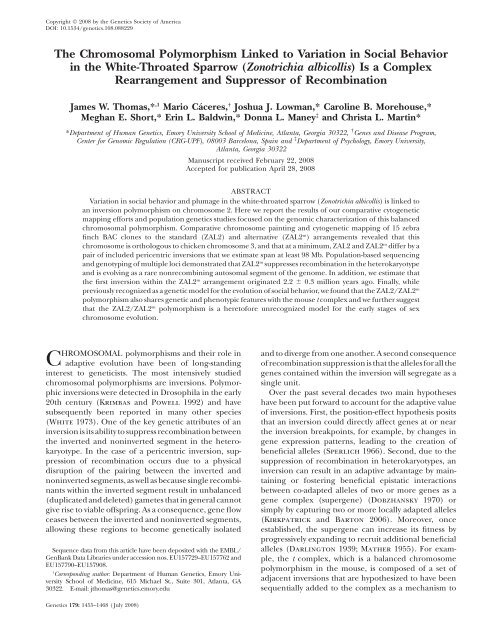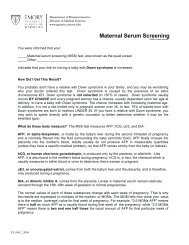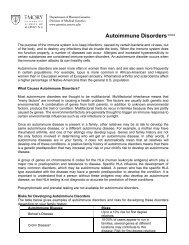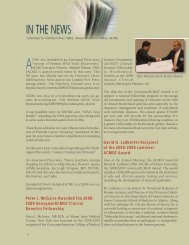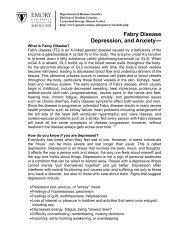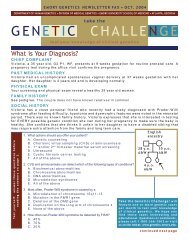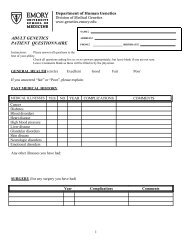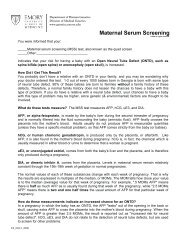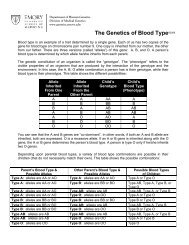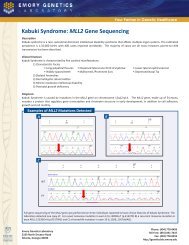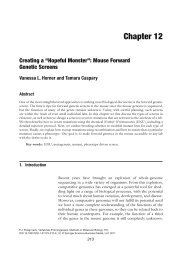The Chromosomal Polymorphism Linked to Variation in ... - Genetics
The Chromosomal Polymorphism Linked to Variation in ... - Genetics
The Chromosomal Polymorphism Linked to Variation in ... - Genetics
You also want an ePaper? Increase the reach of your titles
YUMPU automatically turns print PDFs into web optimized ePapers that Google loves.
Copyright Ó 2008 by the <strong>Genetics</strong> Society of America<br />
DOI: 10.1534/genetics.108.088229<br />
<strong>The</strong> <strong>Chromosomal</strong> <strong>Polymorphism</strong> <strong>L<strong>in</strong>ked</strong> <strong>to</strong> <strong>Variation</strong> <strong>in</strong> Social Behavior<br />
<strong>in</strong> the White-Throated Sparrow (Zonotrichia albicollis) Is a Complex<br />
Rearrangement and Suppressor of Recomb<strong>in</strong>ation<br />
James W. Thomas,* ,1 Mario Cáceres, † Joshua J. Lowman,* Carol<strong>in</strong>e B. Morehouse,*<br />
Meghan E. Short,* Er<strong>in</strong> L. Baldw<strong>in</strong>,* Donna L. Maney ‡ and Christa L. Mart<strong>in</strong>*<br />
*Department of Human <strong>Genetics</strong>, Emory University School of Medic<strong>in</strong>e, Atlanta, Georgia 30322, † Genes and Disease Program,<br />
Center for Genomic Regulation (CRG-UPF), 08003 Barcelona, Spa<strong>in</strong> and ‡ Department of Psychology, Emory University,<br />
Atlanta, Georgia 30322<br />
Manuscript received February 22, 2008<br />
Accepted for publication April 28, 2008<br />
ABSTRACT<br />
<strong>Variation</strong> <strong>in</strong> social behavior and plumage <strong>in</strong> the white-throated sparrow (Zonotrichia albicollis) is l<strong>in</strong>ked <strong>to</strong><br />
an <strong>in</strong>version polymorphism on chromosome 2. Here we report the results of our comparative cy<strong>to</strong>genetic<br />
mapp<strong>in</strong>g efforts and population genetics studies focused on the genomic characterization of this balanced<br />
chromosomal polymorphism. Comparative chromosome pa<strong>in</strong>t<strong>in</strong>g and cy<strong>to</strong>genetic mapp<strong>in</strong>g of 15 zebra<br />
f<strong>in</strong>ch BAC clones <strong>to</strong> the standard (ZAL2) and alternative (ZAL2 m ) arrangements revealed that this<br />
chromosome is orthologous <strong>to</strong> chicken chromosome 3, and that at a m<strong>in</strong>imum, ZAL2 and ZAL2 m differ by a<br />
pair of <strong>in</strong>cluded pericentric <strong>in</strong>versions that we estimate span at least 98 Mb. Population-based sequenc<strong>in</strong>g<br />
and genotyp<strong>in</strong>g of multiple loci demonstrated that ZAL2 m suppresses recomb<strong>in</strong>ation <strong>in</strong> the heterokaryotype<br />
and is evolv<strong>in</strong>g as a rare nonrecomb<strong>in</strong><strong>in</strong>g au<strong>to</strong>somal segment of the genome. In addition, we estimate that<br />
the first <strong>in</strong>version with<strong>in</strong> the ZAL2 m arrangement orig<strong>in</strong>ated 2.2 6 0.3 million years ago. F<strong>in</strong>ally, while<br />
previously recognized as a genetic model for the evolution of social behavior, we found that the ZAL2/ZAL2 m<br />
polymorphism also shares genetic and phenotypic features with the mouse t complex and we further suggest<br />
that the ZAL2/ZAL2 m polymorphism is a here<strong>to</strong>fore unrecognized model for the early stages of sex<br />
chromosome evolution.<br />
CHROMOSOMAL polymorphisms and their role <strong>in</strong><br />
adaptive evolution have been of long-stand<strong>in</strong>g<br />
<strong>in</strong>terest <strong>to</strong> geneticists. <strong>The</strong> most <strong>in</strong>tensively studied<br />
chromosomal polymorphisms are <strong>in</strong>versions. Polymorphic<br />
<strong>in</strong>versions were detected <strong>in</strong> Drosophila <strong>in</strong> the early<br />
20th century (Krimbas and Powell 1992) and have<br />
subsequently been reported <strong>in</strong> many other species<br />
(White 1973). One of the key genetic attributes of an<br />
<strong>in</strong>version is its ability <strong>to</strong> suppress recomb<strong>in</strong>ation between<br />
the <strong>in</strong>verted and non<strong>in</strong>verted segment <strong>in</strong> the heterokaryotype.<br />
In the case of a pericentric <strong>in</strong>version, suppression<br />
of recomb<strong>in</strong>ation occurs due <strong>to</strong> a physical<br />
disruption of the pair<strong>in</strong>g between the <strong>in</strong>verted and<br />
non<strong>in</strong>verted segments, as well as because s<strong>in</strong>gle recomb<strong>in</strong>ants<br />
with<strong>in</strong> the <strong>in</strong>verted segment result <strong>in</strong> unbalanced<br />
(duplicated and deleted) gametes that <strong>in</strong> general cannot<br />
give rise <strong>to</strong> viable offspr<strong>in</strong>g. As a consequence, gene flow<br />
ceases between the <strong>in</strong>verted and non<strong>in</strong>verted segments,<br />
allow<strong>in</strong>g these regions <strong>to</strong> become genetically isolated<br />
Sequence data from this article have been deposited with the EMBL/<br />
GenBank Data Libraries under accession nos. EU157729–EU157762 and<br />
EU157790–EU157908.<br />
1 Correspond<strong>in</strong>g author: Department of Human <strong>Genetics</strong>, Emory University<br />
School of Medic<strong>in</strong>e, 615 Michael St., Suite 301, Atlanta, GA<br />
30322. E-mail: jthomas@genetics.emory.edu<br />
<strong>Genetics</strong> 179: 1455–1468 ( July 2008)<br />
and <strong>to</strong> diverge from one another. A second consequence<br />
of recomb<strong>in</strong>ation suppression is that the alleles for all the<br />
genes conta<strong>in</strong>ed with<strong>in</strong> the <strong>in</strong>version will segregate as a<br />
s<strong>in</strong>gle unit.<br />
Over the past several decades two ma<strong>in</strong> hypotheses<br />
have been put forward <strong>to</strong> account for the adaptive value<br />
of <strong>in</strong>versions. First, the position-effect hypothesis posits<br />
that an <strong>in</strong>version could directly affect genes at or near<br />
the <strong>in</strong>version breakpo<strong>in</strong>ts, for example, by changes <strong>in</strong><br />
gene expression patterns, lead<strong>in</strong>g <strong>to</strong> the creation of<br />
beneficial alleles (Sperlich 1966). Second, due <strong>to</strong> the<br />
suppression of recomb<strong>in</strong>ation <strong>in</strong> heterokaryotypes, an<br />
<strong>in</strong>version can result <strong>in</strong> an adaptive advantage by ma<strong>in</strong>ta<strong>in</strong><strong>in</strong>g<br />
or foster<strong>in</strong>g beneficial epistatic <strong>in</strong>teractions<br />
between co-adapted alleles of two or more genes as a<br />
gene complex (supergene) (Dobzhansky 1970) or<br />
simply by captur<strong>in</strong>g two or more locally adapted alleles<br />
(Kirkpatrick and Bar<strong>to</strong>n 2006). Moreover, once<br />
established, the supergene can <strong>in</strong>crease its fitness by<br />
progressively expand<strong>in</strong>g <strong>to</strong> recruit additional beneficial<br />
alleles (Darl<strong>in</strong>g<strong>to</strong>n 1939; Mather 1955). For example,<br />
the t complex, which is a balanced chromosome<br />
polymorphism <strong>in</strong> the mouse, is composed of a set of<br />
adjacent <strong>in</strong>versions that are hypothesized <strong>to</strong> have been<br />
sequentially added <strong>to</strong> the complex as a mechanism <strong>to</strong>
1456 J. W. Thomas et al.<br />
recruit new alleles and <strong>in</strong>crease the fitness of that<br />
supergene (Hammer et al. 1989).<br />
In addition <strong>to</strong> recruit<strong>in</strong>g beneficial alleles, the suppression<br />
of recomb<strong>in</strong>ation <strong>in</strong> the heterokaryotype along with<br />
prolonged periods of heterozygosity makes polymorphic<br />
<strong>in</strong>versions prone <strong>to</strong> the accumulation of deleterious<br />
recessive mutations. For example, a number of recessive<br />
lethal mutations have been mapped with<strong>in</strong> the t complex<br />
(Kle<strong>in</strong> et al. 1984). <strong>The</strong> most extreme example of prolonged<br />
heterozygosity and lack of recomb<strong>in</strong>ation are the<br />
heterogametic Yand W sex chromosomes, which, due <strong>to</strong> a<br />
variety of forces caused by the lack of recomb<strong>in</strong>ation, will<br />
ultimately genetically deteriorate (Charlesworth and<br />
Charlesworth 2000). Indeed, <strong>in</strong>versions that suppress<br />
recomb<strong>in</strong>ation between pro<strong>to</strong>-Y and X chromosomes are<br />
implicit <strong>in</strong> models of how sex chromosomes can evolve<br />
from ord<strong>in</strong>ary au<strong>to</strong>somes (Ohno 1967). <strong>Chromosomal</strong><br />
<strong>in</strong>versions therefore have unique and established genetic<br />
characteristics that can have a profound <strong>in</strong>fluence on the<br />
evolutionary process.<br />
<strong>The</strong> first chromosomal polymorphisms discovered<br />
<strong>in</strong> birds were a pair of putative pericentric <strong>in</strong>versions<br />
on the second and third chromosome <strong>in</strong> the North<br />
American migra<strong>to</strong>ry songbird, the white-throated sparrow<br />
(Zonotrichia albicollis: order Passeriformes, family<br />
Emberizidae) (Thorneycroft 1966). At the time, it was<br />
already established that a balanced plumage polymorphism<br />
was present <strong>in</strong> this species, such that approximately<br />
one-half the population had a white stripe on<br />
their crown, while the other half of the population had a<br />
tan stripe (Lowther 1961). It was further noted that<br />
sexual selection ma<strong>in</strong>ta<strong>in</strong>s this polymorphism <strong>in</strong> the<br />
population via a strong disassortative mat<strong>in</strong>g preference<br />
(Lowther 1961) such that 96% of observed breed<strong>in</strong>g<br />
pairs are composed of birds from both morphs (Falls<br />
and Kopachena 1994). Thorneycroft (1966, 1975)<br />
found that the arrangement of the second chromosome,<br />
designated the M (metacentric) and then 2 m<br />
(referred <strong>to</strong> here as ZAL2 m ), was always present <strong>in</strong><br />
white-striped (WS) <strong>in</strong>dividuals and absent <strong>in</strong> the tanstriped<br />
(TS) <strong>in</strong>dividuals, thereby demonstrat<strong>in</strong>g that<br />
the white stripe is <strong>in</strong>herited as a dom<strong>in</strong>ant trait l<strong>in</strong>ked <strong>to</strong><br />
ZAL2 m .Thorneycroft’s (1975) detailed populationbased<br />
cy<strong>to</strong>genetic study also revealed that WS birds were<br />
almost exclusively ZAL2/ZAL2 m heterozygotes (217/<br />
218), whereas only one WS bird was found <strong>to</strong> be homozygous<br />
for ZAL2 m . <strong>The</strong> virtual absence of birds homozygous<br />
for ZAL2 m is caused at least <strong>in</strong> part by the low<br />
frequency ( 2.5%) of WS 3 WS breed<strong>in</strong>g pairs (Falls<br />
and Kopachena 1994). Alternatively, Thorneycroft<br />
(1975) suggested that the lack of ZAL2 m homozygotes<br />
could also be attributed <strong>to</strong> the accumulation of one<br />
or more recessive lethal mutations on the <strong>in</strong>verted<br />
chromosome. In either case, the disassortative breed<strong>in</strong>g<br />
pattern provides the mechanism by which ZAL2 m is<br />
ma<strong>in</strong>ta<strong>in</strong>ed as a balanced chromosomal polymorphism<br />
<strong>in</strong> this species.<br />
Behavioral studies of the white-throated sparrow have<br />
revealed a remarkable correlation between the plumage<br />
coloration and dist<strong>in</strong>ct reproductive strategies and<br />
social behaviors. Both WS males and females s<strong>in</strong>g more<br />
than their sex-matched TS counterparts (Falls 1969;<br />
Kopachena and Falls 1993a). WS males defend their<br />
terri<strong>to</strong>ries more aggressively than TS males (Kopachena<br />
and Falls 1993a; Coll<strong>in</strong>s and Houtman 1999) and are<br />
more likely <strong>to</strong> <strong>in</strong>trude <strong>in</strong><strong>to</strong> the terri<strong>to</strong>ries of other males<br />
(Tuttle 2003). WS females are more likely <strong>to</strong> perform<br />
courtship displays, and WS males are more likely <strong>to</strong> engage<br />
<strong>in</strong> copulation outside the social pair bond (Tuttle<br />
2003). TS birds of both sexes feed young more often<br />
dur<strong>in</strong>g the parental phase of the breed<strong>in</strong>g season than<br />
do WS birds (Knap<strong>to</strong>n and Falls 1983; Kopachena<br />
and Falls 1993b). WS males and females thus exhibit<br />
behavior that is more male like than their sex-matched<br />
TS counterparts. Alternative behavioral strategies are<br />
sometimes characterized by measurable endocr<strong>in</strong>e and<br />
neuroendocr<strong>in</strong>e differences between phenotypes (reviewed<br />
<strong>in</strong> Knapp 2003; Sp<strong>in</strong>ney et al. 2006), and such<br />
differences have been detected between the morphs<br />
(Maney et al. 2005; Sp<strong>in</strong>ney et al. 2006; Lake et al. 2008).<br />
<strong>The</strong> neuroendocr<strong>in</strong>e differences between the plumage<br />
morphs therefore suggest a robust but complex mechanism<br />
underly<strong>in</strong>g polymorphic social behavior <strong>in</strong> this<br />
species and represent a fasc<strong>in</strong>at<strong>in</strong>g example of sexchromosome-<strong>in</strong>dependent<br />
differentiation of behavior.<br />
As the white-throated sparrow provides a natural<br />
genetic model of polymorphic social behavior and a<br />
potential rare example of a nonrecomb<strong>in</strong><strong>in</strong>g vertebrate<br />
au<strong>to</strong>somal segment, this species is a compell<strong>in</strong>g target<br />
for comprehensive genomic characterization. Here we<br />
report the <strong>in</strong>itial modern genomic characterization of<br />
ZAL2 m , describe the similarities of the ZAL2/ZAL2 m<br />
balanced polymorphism <strong>to</strong> the t complex, and discuss<br />
the potential of this system as a model for sex chromosome<br />
evolution and for dissect<strong>in</strong>g the genetic basis of<br />
social behavior.<br />
MATERIALS AND METHODS<br />
Animals: All procedures <strong>in</strong>volv<strong>in</strong>g animals were approved<br />
by the Emory University Institutional Animal Care and Use<br />
Committee. White-throated sparrows were collected <strong>in</strong> mist<br />
nets on the campus of Emory University <strong>in</strong> Atlanta dur<strong>in</strong>g<br />
November and December 2005 and 2006. A small blood<br />
sample was taken from a w<strong>in</strong>g ve<strong>in</strong> and sex was confirmed by<br />
PCR us<strong>in</strong>g primers P2 and P8 of Griffiths et al. (1998).<br />
Morph was determ<strong>in</strong>ed accord<strong>in</strong>g <strong>to</strong> criteria described <strong>in</strong><br />
Watt (1986) and Piper and Wiley (1989) and confirmed by<br />
PCR us<strong>in</strong>g the method described <strong>in</strong> Michopoulos et al.<br />
(2007). <strong>The</strong> birds were housed <strong>in</strong> the Emory animal care<br />
facility <strong>in</strong> walk-<strong>in</strong> flight cages and supplied ad libitum with<br />
food and water.<br />
Cell culture: White-throated sparrow fibroblast cell cultures<br />
were established from a tissue homogenate produced by<br />
manual and enzymatic digestion us<strong>in</strong>g a pro<strong>to</strong>col adapted<br />
from I<strong>to</strong>h and Arnold (2005). Kidney tissue was washed <strong>in</strong>
5 ml complete media ½MEM (Invitrogen/Gibco, Carlsbad,<br />
California) enhanced with 0.6% glucose, 10% heat-<strong>in</strong>activated<br />
fetal bov<strong>in</strong>e serum (Invitrogen/Gibco), 5000 units/ml penicill<strong>in</strong><br />
and 5 mg/ml strep<strong>to</strong>myc<strong>in</strong> (Invitrogen/Gibco), and<br />
10% chicken serum (Sigma-Aldrich, St. Louis)Š, manually<br />
m<strong>in</strong>ced, and resuspended <strong>in</strong> 0.5 ml PBS (Invitrogen/Gibco).<br />
Cells were <strong>in</strong>cubated with collagenase B for 15–30 m<strong>in</strong> at 37°.<br />
To ensure complete homogenization, the tissue suspension<br />
was suctioned through a Pasteur pipette and supplemented<br />
with 10 ml of complete media. Cultures were <strong>in</strong>cubated at 37°.<br />
Metaphase chromosome preparations: When the cultures<br />
reached 80% confluency, KaryoMAX colcemid (30 ng) (Invitrogen/Gibco)<br />
was added and the cells were <strong>in</strong>cubated<br />
overnight at 37° for 12–16 hr. Additional colcemid (0.5 mg)<br />
was added, and the cells were further <strong>in</strong>cubated for 3–4 hr. <strong>The</strong><br />
cells were tryps<strong>in</strong>ized from the surface of the flask us<strong>in</strong>g<br />
TrypLE Express (Invitrogen/Gibco) for 15 m<strong>in</strong> at 37°. Cells<br />
were r<strong>in</strong>sed with 1.5 ml of media and centrifuged, and the<br />
pellet was suspended <strong>in</strong> KCl:sodium citrate (60:40; 0.075 m:<br />
0.27 m) hypo<strong>to</strong>nic solution and <strong>in</strong>cubated for 20 m<strong>in</strong> at 37°.<br />
<strong>The</strong> cells were then treated with 1 ml of methanol:glacial acetic<br />
acid (3:1; 100%:17.4 n) fixative, centrifuged, and resuspended<br />
<strong>in</strong> 10 ml fixative. This f<strong>in</strong>al step was repeated two times before<br />
metaphase slide preparation.<br />
Identification of zebra f<strong>in</strong>ch BAC clones: Zebra f<strong>in</strong>ch BAC<br />
clones for use <strong>in</strong> the fluorescence <strong>in</strong> situ hybridization (FISH)<br />
studies are listed <strong>in</strong> Table 1 and were identified either by direct<br />
screen<strong>in</strong>g of a zebra f<strong>in</strong>ch genomic library or by comparative<br />
mapp<strong>in</strong>g of zebra f<strong>in</strong>ch BAC-end sequences <strong>to</strong> the chicken<br />
genome. Hybridization screen<strong>in</strong>g us<strong>in</strong>g overgo probes was<br />
performed on the TG_Ba zebra f<strong>in</strong>ch genomic library (Luo<br />
et al. 2006) as described <strong>in</strong> Thomas et al. (2002). <strong>The</strong> probes<br />
used <strong>to</strong> screen the library were either ‘‘universal’’ overgo<br />
hybridization probes derived from sequences conserved<br />
between chicken and humans (Kellner et al. 2005) or speciesspecific<br />
probes designed on the basis of zebra f<strong>in</strong>ch whole-<br />
<strong>Genetics</strong> of the White-Throated Sparrow 1457<br />
TABLE 1<br />
Zebra f<strong>in</strong>ch BAC clones used for cy<strong>to</strong>genetic mapp<strong>in</strong>g<br />
Clone name Library Gene a Orthologous position <strong>in</strong> the chicken genome b<br />
GenBank accession or trace<br />
<strong>in</strong>ternal identifier no.<br />
187L05 TG_Ba ARHGAP21 Chromosome 2: 16,718,745–16,861,796 AC148570.2<br />
13O3 TG_Ba ANKIB1 Chromosome 2: 22,537,415–22,690,751 AC148379.2<br />
156C22 TGMCBa C20orf74 Chromosome 3: 3,687,583–NA 1290208116<br />
94A01 TG_Ba Chromosome 3: 8,004,343–NA 908596196<br />
77A01 TG_Ba Chromosome 3: 19,353,357–NA 908596257<br />
56A01 TG_Ba Chromosome 3: 20,528,587–20,641,054 908596265 and 908596251<br />
300O4 TG_Ba T Chromosome 3: 44,726,054–44,838,315 AC154073.2<br />
13A01 TG_Ba Chromosome 3: 49,895,964–NA 908596109<br />
21H11 TGMCBa Chromosome 3: 61,431,610–61,663,590 1277186752 and 1277186958<br />
352K13 TG_Ba TRMT11 Chromosome 3: 62,158,404–62,162,644 NA<br />
91E01 TGMCBa DSE Chromosome 3: 66,430,196–NA 1277187497<br />
120H07 TGMCBa Chromosome 3: 71,135,240–71,290,704 1290207418 and 1290206795<br />
64A01 TG_Ba Chromosome 3: NA–79,240,792 CZ550179<br />
71A01 TG_Ba Chromosome 3: 81,966,117–82,080,690 908596235 and 908596264<br />
5K13 TG_Ba FAM83B Chromosome 3: 90,507,078–90,508,264 NA<br />
55A01 TG_Ba Chromosome 3: NA–101,927,610 CZ550161<br />
258I11 TG_Ba SUPT3H Chromosome 3: 112,085,047–112,228,350 AC159936.2<br />
NA, not available.<br />
a<br />
Gene names are listed for BAC clones that fully or partially conta<strong>in</strong>ed loci <strong>in</strong>cluded <strong>in</strong> the population-based sequenc<strong>in</strong>g and/<br />
or genotyp<strong>in</strong>g studies.<br />
b<br />
<strong>The</strong> orthologous positions of the zebra f<strong>in</strong>ch BAC clones <strong>in</strong> the chicken genome were based on alignments of zebra f<strong>in</strong>ch<br />
complete BAC or BAC-end sequences <strong>to</strong> the chicken genome assembly (galGal3). In the case of clones 352K13 and 5K13, the<br />
orthologous position was estimated on the basis of the location of the hybridization probes used <strong>to</strong> identify those BACs.<br />
genome shotgun sequences generated at the Wash<strong>in</strong>g<strong>to</strong>n University<br />
Genome Sequenc<strong>in</strong>g Center and downloaded from the<br />
Trace Archive at NCBI (http://www.ncbi.nlm.nih.gov/Traces/<br />
trace.cgi?). Zebra f<strong>in</strong>ch BAC-end sequences from the TA_Ba<br />
and TGMCBa (https://www.genome.clemson.edu/) libraries<br />
were downloaded from NCBI and mapped <strong>to</strong> the chicken genome<br />
(galGal3) (Hillier et al. 2004) by MEGABLASTsearches.<br />
Prior <strong>to</strong> their use as a probe <strong>in</strong> the FISH studies, the identity<br />
of each BAC clone was confirmed. In the case of the clones<br />
isolated by screen<strong>in</strong>g the genomic library, complete sequenc<strong>in</strong>g<br />
and/or secondary hybridization was performed, whereas BAC<br />
clones identified by BLAST searches were confirmed by PCR.<br />
<strong>The</strong> overgo probe and PCR primer sequences used <strong>to</strong> identify<br />
and/or confirm the BAC clones are available from the authors<br />
upon request.<br />
FISH analysis: BAC DNA was isolated from overnight<br />
cultures with the appropriate antibiotic us<strong>in</strong>g an alkal<strong>in</strong>e lysis<br />
procedure or an au<strong>to</strong>mated extraction system (Au<strong>to</strong>gen,<br />
Hollis<strong>to</strong>n, MA). Fluorescently labeled nucleotides ½spectrum<br />
orange-dUTP, spectrum green-dUTP (Abbott Molecular, Des<br />
Pla<strong>in</strong>es, IL) or diethylam<strong>in</strong>ocoumar<strong>in</strong>-5-dUTP (Perk<strong>in</strong>Elmer<br />
Life Sciences, Bos<strong>to</strong>n)Š were <strong>in</strong>corporated <strong>in</strong><strong>to</strong> the BAC DNA<br />
us<strong>in</strong>g a standard nick translation or random prim<strong>in</strong>g reaction.<br />
Chicken chromosome pa<strong>in</strong>t<strong>in</strong>g probes (Griff<strong>in</strong> et al. 1999)<br />
were k<strong>in</strong>dly provided by H. Tempest and D. K. Griff<strong>in</strong> and were<br />
labeled us<strong>in</strong>g 0.5 ml of secondary PCR products and fluorescent<br />
nucleotides <strong>in</strong> a standard random prim<strong>in</strong>g reaction.<br />
Slides were baked at 73° for proper ag<strong>in</strong>g, washed <strong>in</strong> 23 SSC at<br />
37° for 30 m<strong>in</strong>, and dehydrated sequentially <strong>in</strong> 70, 80, and 95%<br />
ice-cold ethanol. Chromosomes were denatured <strong>in</strong> 70%<br />
formamide/23 SSC at 75° for 30 sec and then dehydrated as<br />
before. Prior <strong>to</strong> hybridization, probes were denatured at 75°<br />
for 7 m<strong>in</strong> and reannealed at 45° for 1–10 m<strong>in</strong>. Chromosome<br />
spreads were hybridized for 36 hr at 37°. Slides were washed <strong>in</strong><br />
0.43 SSC/0.3% NP-40 at 75° for 2 m<strong>in</strong>, washed <strong>in</strong> 0.23 SSC/<br />
0.1% NP-40 at room temperature for 30 sec, and counter-
1458 J. W. Thomas et al.<br />
sta<strong>in</strong>ed with DAPI for 3 m<strong>in</strong>. Slides were mounted <strong>in</strong><br />
VectaShield antifade solution (Vec<strong>to</strong>r Labora<strong>to</strong>ries, Burl<strong>in</strong>game,<br />
CA) and analyzed us<strong>in</strong>g digital imag<strong>in</strong>g with a CCD<br />
camera and software (SmartCapture 2, Digital Scientific,<br />
Cambridge, UK).<br />
Genomic DNA: Genomic DNA used <strong>in</strong> this study was<br />
extracted from blood and/or other tissues. <strong>The</strong> Z. querula<br />
and Z. leucophry tissue samples were k<strong>in</strong>dly provided by <strong>The</strong><br />
Burke Museum of Natural His<strong>to</strong>ry and Culture.<br />
DNA sequenc<strong>in</strong>g: PCR primers were designed from zebra<br />
f<strong>in</strong>ch genomic or cDNA sequence with three or fewer<br />
mismatches compared <strong>to</strong> the orthologous chicken sequence.<br />
A complete list of the PCR primers used <strong>in</strong> this study along<br />
with the orthologous positions <strong>in</strong> the chicken genome and<br />
specific anneal<strong>in</strong>g temperatures are listed <strong>in</strong> Table 2. PCR<br />
reactions for each locus were performed <strong>in</strong> a 25-ml reaction<br />
volume, <strong>in</strong>clud<strong>in</strong>g 75 ng of genomic DNA, 1.5 units of Taq<br />
DNA polymerase (Invitrogen), the manufacturer’s buffer<br />
( MgCl 2), 20 pmol of each primer, 0.2 mm dNTPs, and 1.5<br />
mm MgCl2. <strong>The</strong> PCR cycle conditions <strong>in</strong>cluded an <strong>in</strong>itial<br />
denatur<strong>in</strong>g step at 94° for 5 m<strong>in</strong>, followed by 35 cycles of 94°<br />
for 30 sec, 55° or 58° for 30 sec, and 72° for 1 m<strong>in</strong>, and end<strong>in</strong>g<br />
with a f<strong>in</strong>al 7-m<strong>in</strong> extension at 72°. PCR amplicons were<br />
treated with shrimp alkal<strong>in</strong>e phosphatase and exonuclease I<br />
(USB) and then directly sequenced with the PCR primers or<br />
<strong>in</strong>ternal primers as needed.<br />
DNA sequence analysis: Nucleotide polymorphisms were<br />
au<strong>to</strong>matically called us<strong>in</strong>g SNPdetec<strong>to</strong>r (Zhang et al. 2005)<br />
and manually reviewed prior <strong>to</strong> further analyses. Annotation<br />
of gene features was lifted from the available <strong>in</strong>formation from<br />
the chicken genome. Multiple sequence alignments of each<br />
loci were carried out with the MUSCLE program (Edgar<br />
2004), followed by manual <strong>in</strong>spection <strong>to</strong> check for potential<br />
errors. To estimate sequence haplotypes and assign variants <strong>to</strong><br />
ZAL2 or ZAL2 m chromosomes, the genotypes of the variable<br />
positions <strong>in</strong> the six WS and four TS birds were analyzed with<br />
the program PHASE version 2.1 us<strong>in</strong>g default parameters<br />
(Stephens et al. 2001). For loci physically l<strong>in</strong>ked <strong>to</strong> ZAL2 and<br />
ZAL2 m , a fictitious biallelic position was added <strong>in</strong> heterozygosis<br />
(WS) or homozygosis (TS) <strong>to</strong> account for the presence of<br />
the ZAL2 m arrangement. In each case, at least two <strong>in</strong>dependent<br />
PHASE runs were done, and only positions that could be<br />
reliably assigned <strong>to</strong> a particular haplotype were <strong>in</strong>cluded <strong>in</strong> the<br />
analysis. Population genetic measures on either raw genotypes<br />
or estimated haplotypes were calculated by us<strong>in</strong>g the DnaSP<br />
version 4.10 software (Rozas et al. 2003), except for the FST<br />
values between ZAL2 and ZAL2 m arrangements, which were<br />
calculated with the Arlequ<strong>in</strong> version 3.01 program (Excoffier<br />
et al. 2005). Phylogenetic trees were obta<strong>in</strong>ed with the<br />
neighbor-jo<strong>in</strong><strong>in</strong>g method based on the Kimura two-parameter<br />
distances (Kimura 1980) from 100 or 1000 bootstrap replicates<br />
us<strong>in</strong>g the PHYLIP software package (http://evolution.<br />
genetics.wash<strong>in</strong>g<strong>to</strong>n.edu/phylip/doc/ma<strong>in</strong>.html) (Felsenste<strong>in</strong><br />
2004), and similar results were obta<strong>in</strong>ed us<strong>in</strong>g the UPGMA<br />
and maximum-likelihood methods. Branch lengths were<br />
calculated us<strong>in</strong>g the BASEML module of the PAML program<br />
(Yang 1997).<br />
Molecular dat<strong>in</strong>g: DNA sequences of the mi<strong>to</strong>chondrial<br />
cy<strong>to</strong>chrome b (CYTB) and cy<strong>to</strong>chrome c oxidase subunit I<br />
(COX1) genes were retrieved from GenBank for Junco hyemalis<br />
(accession no. DQ432957.1 and AF290161.1), Z. albicollis<br />
(accession no. DQ434837 and AF284076.1), Z. querula (accession<br />
no. DQ434242.1 and U40173.1), and Z. leucophrys (accession<br />
no. DQ434845.1 and AF305744.1), and aligned with<br />
ClustalW ( Jeanmoug<strong>in</strong> et al. 1998). Pairwise divergence and<br />
standard deviations were derived with Kimura’s two-parameter<br />
model as implemented <strong>in</strong> MEGA (Kumar et al. 2004) and used<br />
<strong>to</strong> estimate the divergence times between Z. albicollis and the<br />
TABLE 2<br />
PCR primers used for sequenc<strong>in</strong>g and/or genotyp<strong>in</strong>g<br />
Anneal<strong>in</strong>g<br />
temperature<br />
Reverse<br />
primer<br />
Forward<br />
primer<br />
Orthologous position<br />
<strong>in</strong> the chicken genome a<br />
Gene<br />
ARHGAP21 Chromosome 2: 16,833,935–16,835,090 AGGCATCACCAAACACTTCTG CTTTAATTCGGCGACAACTTTC 58°<br />
ANKIB1 Chromosome 2: NA–22,542,469 TTCCATTGTCTGTTGCCTAATGb AGCCTTACTGCTCTTTCACAGC 58°<br />
C20orf74 Chromosome 3: 3,692,168–3,693,752 CCTGGGATAGAAGGTAGGAAGAG AAATCTTCATAGGCCTGGCTTC 58°<br />
THADA Chromosome 3: 26,317,068–26,318,103 TAGTTTGGTCATGGTTCCCTTC TGCATCAGTCTTGTTGTCTTTG 58°<br />
MAP3K4 Chromosome 3: 47,163,649–47,164,047 TGCTAAGCTTCCAGTCTCTGTG GATTTGCAAACTCCTTCTCCTG 58°<br />
ESR1 Chromosome 3: 51,039,397–51,041,118 AGCACCTTGAAATCTCTGGAAG ACTGCAAGGAATGAGATGAAGC 58°<br />
ESR1 Chromosome 3: 51,041,096–51,041,395 AGCTTCATCTCATTCCTTGCAG AAGTTAGCCAGACAATCCTTGC 55°<br />
VIP Chromosome 3: 51,393,113–51,393,983 ACTGACAACTACAGCCGCTTTC CAAGATGTTCTGCTTCATCTCG 55°<br />
REPS1 Chromosome 3: 56,093,603–56,094,561 CAGACTTCAGCCAGTTTGAGG CATCTGCTTTGGCAACTCTAAG 58°<br />
TRMT11 Chromosome 3: 62,161,143–62,162,631 TCCTTCAGAAGAGATGGCAAG GTTCTTCAAAGATGCATAGAGC 58°<br />
DSE Chromosome 3: 66,486,488–66,486,849 GAAGGACTACGTAGGGATCGTG CCTCATCTTCATCTACAGGCAAC 58°<br />
CGA Chromosome 3: 79,317,477–79,319,113 CCAGATGGAGAGTTTCTCATGC GTCTTCTTGGACCTCATTGGAG 55°<br />
FAM83B Chromosome 3: 90,508,586–90,509,023 TTCCTTGGCTTCAGTTTCTAGC GCAAGATTTACCTTTGGTCGTG 58°<br />
SUPT3H Chromosome 3: 111,942,733–111,943,480 CAGATATGGCATGACTGAATGG CTGACAGCAAAGAAAGCATCC 58°<br />
NA, not available.<br />
a<br />
Coord<strong>in</strong>ates are based on the galGal3 assembly of the chicken genome.<br />
b Primer sequence from Z. albicollis.
other three species assum<strong>in</strong>g a divergence rate of 0.02<br />
nucleotide substitutions/million years (Klicka and Z<strong>in</strong>k<br />
1997). <strong>The</strong> result<strong>in</strong>g dates were similar <strong>to</strong> that reported<br />
previously (Z<strong>in</strong>k et al. 1991). <strong>The</strong> age of the ZAL2 m arrangement<br />
was computed as the product of the divergence time<br />
between Z. albicollis and J. hyemalis and the ratio of the net<br />
number of nucleotide substitutions between ZAL2 and ZAL2 m<br />
(da) and between Z. albicollis and J. hyemalis (Ka) <strong>in</strong> the 6434.5<br />
synonymous or noncod<strong>in</strong>g positions sequenced <strong>in</strong> both<br />
species. <strong>The</strong> net number of nucleotide substitutions between<br />
each l<strong>in</strong>eage was calculated by subtract<strong>in</strong>g an approximation<br />
of the ancestral <strong>in</strong>traspecies polymorphism level, represented<br />
by the nucleotide diversity between the ZAL2 sequences, from<br />
the average number of nucleotide substitutions per site<br />
between arrangements (dxy) or the nucleotide divergence<br />
between species (K) generated with the DnaSP program<br />
(Rozas et al. 2003).<br />
RFLP genotyp<strong>in</strong>g: Genotyp<strong>in</strong>g assays for an NdeI restriction<br />
fragment length polymorphism (RFLP) at the THADA locus<br />
and for a BssSI RFLP at the FAM83B locus were performed as<br />
follows. PCR amplicons (5–10 ml of the PCR reaction) from the<br />
THADA and FAM83B loci were digested <strong>in</strong> the presence of NdeI<br />
(25–35 units, NEB) or BssSI (2 units, NEB), respectively, for<br />
4.5 hr at 37° <strong>in</strong> a <strong>to</strong>tal reaction volume of 50 ml. <strong>The</strong> digested<br />
products were then subjected <strong>to</strong> electrophoresis <strong>in</strong> a 2 or 4%<br />
agarose gel <strong>to</strong> visualize the ZAL2 and ZAL2 m alleles. For the<br />
THADA locus, the ZAL2 allele was detected by the presence of<br />
two bands of 1200 and 400 bp represent<strong>in</strong>g NdeI-digested<br />
fragments, while the ZAL2 m allele was associated with a s<strong>in</strong>gle<br />
1600-bp undigested fragment. For the FAM83B locus, the<br />
ZAL2 allele was represented by two bands of 354 and 81 bp<br />
represent<strong>in</strong>g BssSI-digested fragments, while the ZAL2 m allele<br />
was associated with a s<strong>in</strong>gle 435-bp undigested fragment. <strong>The</strong><br />
locations of these polymorphisms are annotated <strong>in</strong> the respective<br />
GenBank records. In addition, a simple <strong>in</strong>del polymorphism<br />
at the DSE locus (ZAL2 allele ¼ 350 bp, ZAL2 m allele ¼<br />
400 bp) was genotyped by electrophoresis of the PCR products<br />
on a 4% agarose gel (see Table 2 for the DSE primer sequences).<br />
RESULTS<br />
Comparative chromosome pa<strong>in</strong>t<strong>in</strong>g <strong>in</strong> the whitethroated<br />
sparrow: Studies focused on the evolution of<br />
avian karyotypes have been advanced by the development<br />
and utility of chicken (Gallus gallus) chromosome<br />
<strong>Genetics</strong> of the White-Throated Sparrow 1459<br />
Figure 1.—Cy<strong>to</strong>genetic mapp<strong>in</strong>g of the ZAL2<br />
and ZAL2 m chromosomes. Metaphase chromosome<br />
spreads from WS females were used for<br />
FISH mapp<strong>in</strong>g. Note that the karyotype of the<br />
white-throated sparrow, like other birds, is composed<br />
of a few large macrochromosomes and<br />
numerous microchromosomes. (A) Chicken<br />
chromosome 3 pa<strong>in</strong>t<strong>in</strong>g probe hybridization <strong>to</strong><br />
ZAL2 and ZAL2 m . (B–E) Localization of zebra<br />
f<strong>in</strong>ch BAC clones orthologous <strong>to</strong> chicken chromosome<br />
3 on ZAL2 and ZAL2 m . <strong>The</strong> color-coded<br />
arrows correspond<strong>in</strong>g <strong>to</strong> each BAC represent the<br />
position of each probe on each chromosome.<br />
Note the change <strong>in</strong> relative order between the alternative<br />
arrangements for BACs 64A1, 71A1, and<br />
5K13, and the shift <strong>in</strong> proximity <strong>to</strong>ward the telomere<br />
of the long arm for 21H11, 55A1, and<br />
352K14 on ZAL2 m relative <strong>to</strong> ZAL2.<br />
pa<strong>in</strong>ts for comparative mapp<strong>in</strong>g (ZOO-FISH) <strong>in</strong> a diverse<br />
sampl<strong>in</strong>g of birds (Shetty et al. 1999; Guttenbach<br />
et al. 2003; I<strong>to</strong>h and Arnold 2005; Nanda et al. 2006;<br />
Nishida-Umehara et al. 2007). Those efforts and other<br />
gene-based comparative mapp<strong>in</strong>g studies (Backstrom<br />
et al. 2006; I<strong>to</strong>h et al. 2006) have demonstrated that<br />
conserved synteny among birds is quite extensive with<br />
many chicken chromosomes display<strong>in</strong>g a one-<strong>to</strong>-one<br />
orthologous relationship <strong>to</strong> chromosomes from other<br />
species, <strong>in</strong>clud<strong>in</strong>g passer<strong>in</strong>es (Guttenbach et al. 2003;<br />
Derjusheva et al. 2004; I<strong>to</strong>h and Arnold 2005), which<br />
diverged from the chicken l<strong>in</strong>eage 100 million years<br />
ago (MYA) (van Tu<strong>in</strong>en and Hedges 2001). <strong>The</strong> development<br />
of a comparative map with chicken, which has<br />
an assembled and annotated genome (Hillier et al.<br />
2004), can therefore provide a strong basis for predict<strong>in</strong>g<br />
the gene content, but not necessarily the gene order, of<br />
an orthologous chromosome <strong>in</strong> another bird. Previous<br />
comparative mapp<strong>in</strong>g <strong>in</strong> two songbirds, the chaff<strong>in</strong>ch<br />
(Fr<strong>in</strong>gilla coelebs) and zebra f<strong>in</strong>ch (Taeniopygia guttata),<br />
which diverged from the white-throated sparrow with<strong>in</strong><br />
the past 20 million years and 20–45 MYA, respectively<br />
(Barker et al. 2004), identified chicken chromosome<br />
3 (GGA3) as the ortholog of chromosome 2<br />
<strong>in</strong> those species (Derjusheva et al. 2004; I<strong>to</strong>h and<br />
Arnold 2005). We therefore hypothesized that the<br />
ZAL2 and ZAL2 m chromosomes were also orthologous<br />
<strong>to</strong> GGA3. To test this hypothesis, we performed FISH<br />
us<strong>in</strong>g the GGA3 pa<strong>in</strong>t on metaphase spreads from a<br />
WS bird with the ZAL2/ZAL2 m heterokaryotype (Figure<br />
1A). As predicted, the GGA3 pa<strong>in</strong>t identified only<br />
ZAL2 and ZAL2 m as the orthologous chromosome <strong>in</strong><br />
the white-throated sparrow. In addition, we performed<br />
FISH us<strong>in</strong>g chromosome pa<strong>in</strong>ts for three other macrochromosomes,<br />
GGA1, 2, and 4, and were able <strong>to</strong><br />
def<strong>in</strong>itively exclude those chromosomes as orthologs<br />
of ZAL2 and ZAL2 m (data not shown). Thus, ZAL2 and<br />
ZAL2 m are orthologous <strong>to</strong> GGA3.<br />
Cy<strong>to</strong>genetic mapp<strong>in</strong>g of the ZAL2 m chromosomal<br />
rearrangement: Hav<strong>in</strong>g established that ZAL2 and
1460 J. W. Thomas et al.<br />
ZAL2 m are orthologous <strong>to</strong> GGA3, we next turned our<br />
attention <strong>to</strong>ward characteriz<strong>in</strong>g the rearrangement that<br />
led <strong>to</strong> the ZAL2 m chromosome. On the basis of the<br />
position of the centromere, which is submetacentric on<br />
ZAL2 but metacentric on ZAL2 m , Thorneycroft<br />
(1966, 1975) hypothesized that this chromosomal polymorphism<br />
<strong>in</strong>volved a pericentric <strong>in</strong>version. To map the<br />
putative <strong>in</strong>version, we leveraged the assembled chicken<br />
genome and the genomic resources available for the<br />
zebra f<strong>in</strong>ch <strong>to</strong> identify a set of zebra f<strong>in</strong>ch BAC clones<br />
orthologous <strong>to</strong> 15 dist<strong>in</strong>ct loci distributed along GGA3<br />
(see Table 1 and materials and methods). This set of<br />
zebra f<strong>in</strong>ch BAC clones was then systematically mapped<br />
<strong>to</strong> metaphase spreads from WS birds with the ZAL2/<br />
ZAL2 m heterokaryotype us<strong>in</strong>g a comb<strong>in</strong>ation of s<strong>in</strong>gle,<br />
dual, and tricolored FISH <strong>to</strong> resolve the order of clones<br />
along the <strong>in</strong>dividual chromosomes. Representative<br />
images of the FISH results are shown <strong>in</strong> Figure 1, B–E,<br />
and a complete summary of the cy<strong>to</strong>genetic mapp<strong>in</strong>g is<br />
illustrated <strong>in</strong> Figure 2.<br />
In complete concordance with the results from<br />
chicken chromosome pa<strong>in</strong>t<strong>in</strong>g studies, all 15 zebra<br />
f<strong>in</strong>ch BAC clones selected on the basis of their orthology<br />
<strong>to</strong> GGA3 mapped <strong>to</strong> both ZAL2 and ZAL2 m . <strong>The</strong><br />
majority of BAC clones (12/15) were <strong>in</strong> the same<br />
relative order on ZAL2 and ZAL2 m and localized <strong>to</strong><br />
the same arm of both chromosomes. For example, zebra<br />
f<strong>in</strong>ch BACs 21H11 and 120H07 were localized <strong>to</strong> the<br />
same position relative <strong>to</strong> the closest flank<strong>in</strong>g marker(s)<br />
on the p- and q-arms of both ZAL2 and ZAL2 m (Figure<br />
1B and Figure 2). However, the proximity of these BACs<br />
<strong>to</strong> the centromere, or the end of the q-arm, was not<br />
equivalent. BACs that mapped <strong>to</strong> the q-arm on both<br />
ZAL2 and ZAL2 m were notably shifted <strong>to</strong>ward the<br />
telomere on ZAL2 m vs. ZAL2. For example, 21H11,<br />
352K14, and 55A1 are clearly more telomeric on ZAL2 m<br />
vs. ZAL2, but a comparable distance from the centromere<br />
on both chromosomes (Figure 1, B, D, and E). On<br />
the p-arm, 258I11 and 120H07 mapped very close <strong>to</strong> the<br />
telomere of the p-arm on both chromosomes but were<br />
clearly farther from the centromere on ZAL2 m vs. ZAL2.<br />
<strong>The</strong>se shifts <strong>in</strong> the position of the mapped BAC clones<br />
are consistent with movement of a large segment of the<br />
distal region of the q-arm of ZAL2 <strong>to</strong> the p-arm of<br />
ZAL2 m . Indeed, the rema<strong>in</strong><strong>in</strong>g three zebra f<strong>in</strong>ch BACs<br />
(64A01, 5K13, and 71A1) were the most distal markers<br />
on the q-arm of ZAL2, but mapped <strong>to</strong> the central<br />
portion of the p-arm of ZAL2 m (Figure 1, C–E).<br />
Although the order of these three BACs relative <strong>to</strong><br />
one another on the q-arm of ZAL2 and the p-arm of<br />
ZAL2 m could not be unambiguously resolved, this result<br />
is consistent with a pericentric <strong>in</strong>version. Yet, because<br />
these three BACs were flanked by markers that did not<br />
change their relative order between ZAL2 and ZAL2 m<br />
(Figure 1, C–E, and Figure 2), a s<strong>in</strong>gle pericentric<br />
<strong>in</strong>version can be excluded as the sole molecular<br />
mechanism that gave rise <strong>to</strong> ZAL2 m . Our cy<strong>to</strong>genetic<br />
Figure 2.—Summary of the cy<strong>to</strong>genetic mapp<strong>in</strong>g of ZAL2<br />
and ZAL2 m and gene flow between the chromosomes. <strong>The</strong> positions<br />
of the zebra f<strong>in</strong>ch BAC clones mapped by FISH <strong>to</strong> the<br />
ZAL2 (left) and ZAL2 m (right) chromosomes are <strong>in</strong>dicated.<br />
In cases where the order of the BAC clones could not be reliably<br />
resolved, the clones were grouped <strong>to</strong>gether (vertical<br />
l<strong>in</strong>e) and listed <strong>in</strong> an arbitrary order. L<strong>in</strong>es between the chromosomes<br />
<strong>in</strong>dicate the relative position of the markers on the<br />
two chromosomes. Centromeres are represented by solid<br />
circles. <strong>The</strong> gene names and FST values for loci <strong>in</strong>cluded <strong>in</strong><br />
the population genetics studies are listed <strong>to</strong> the right of<br />
ZAL2 m <strong>in</strong> their respective positions along this chromosome.<br />
<strong>The</strong> positions of the genes were directly determ<strong>in</strong>ed by FISH<br />
(*) or <strong>in</strong>ferred on the basis of flank<strong>in</strong>g markers and the orthologous<br />
position on GGA3 (†). <strong>The</strong> subset of the loci that<br />
were genotyped <strong>in</strong> a larger panel of WS and TS birds are denoted<br />
by ‘‘‡.’’ <strong>The</strong> ‘‘§’’ <strong>in</strong>dicates that the VIP genotyp<strong>in</strong>g results<br />
were previously reported <strong>in</strong> Michopoulos et al. (2007).<br />
mapp<strong>in</strong>g data are therefore consistent with a pair of<br />
<strong>in</strong>versions lead<strong>in</strong>g <strong>to</strong> the ZAL2/ZAL2 m polymorphism<br />
(see discussion).<br />
Gene flow between ZAL2 and ZAL2 m chromosomes:<br />
In the heterokaryotype, pericentric <strong>in</strong>versions can act as<br />
suppressors of recomb<strong>in</strong>ation by physically disrupt<strong>in</strong>g<br />
the pair<strong>in</strong>g of the normal and <strong>in</strong>verted chromosomes.<br />
While our cy<strong>to</strong>genetic mapp<strong>in</strong>g revealed that a large
fraction of the loci on ZAL2 and ZAL2 m are col<strong>in</strong>ear<br />
(Figure 2), the nature of the rearrangement is such that<br />
s<strong>in</strong>gle recomb<strong>in</strong>ants along the majority of the chromosome<br />
would lead <strong>to</strong> duplicated/deleted gametes, which<br />
would effectively suppress recomb<strong>in</strong>ation. Thus, <strong>to</strong><br />
directly measure the pattern of gene flow between the<br />
ZAL2 and ZAL2 m arrangements, we sequenced 8657 bp<br />
correspond<strong>in</strong>g <strong>to</strong> 10 loci that mapped <strong>to</strong> these chromosomes<br />
(Figure 2) <strong>in</strong> six WS (obligate ZAL2/ZAL2 m ) and<br />
four TS (obligate ZAL2/ZAL2) <strong>in</strong>dividuals. A series of<br />
population genetic measures calculated for the 10 loci<br />
<strong>in</strong> WS and TS <strong>in</strong>dividuals showed clearly different results<br />
for the loci with<strong>in</strong> vs. outside the region rearranged<br />
between ZAL2 and ZAL2 m (Table 3). Specifically,<br />
accord<strong>in</strong>g <strong>to</strong> the raw genotype data, the 9 loci with<strong>in</strong><br />
the rearranged region displayed very high heterozygosity<br />
values <strong>in</strong> WS (0.57–1.00) compared <strong>to</strong> TS birds<br />
(0–0.17) and positive Tajima’s D values, which are consistent<br />
with an excess of nucleotide variants at high<br />
frequency (Tajima 1989). Similarly, when the <strong>in</strong>dividual<br />
haplotypes for these loci were estimated, ZAL2 chromosomes<br />
had five times higher nucleotide diversity (p)<br />
than the ZAL2 m chromosomes, and the FST values<br />
between the two chromosomal arrangements ranged<br />
from 0.7 <strong>to</strong> the maximum value of 1, which is <strong>in</strong>dicative<br />
of a great degree of genetic differentiation between<br />
ZAL2 and ZAL2 m (Table 3 and Figure 2).<br />
In contrast, clearly dist<strong>in</strong>ct results were observed for<br />
the lone gene, SUPT3H, l<strong>in</strong>ked <strong>to</strong> ZAL2 and ZAL2 m that<br />
maps outside the rearrangement. Specifically, SUPT3H<br />
did not have a high level of heterozygosity <strong>in</strong> WS vs. TS<br />
birds; was associated with a negative Tajima’s D, which is<br />
consistent with an enrichment of low-frequency variants;<br />
had comparable levels of nucleotide diversity; and<br />
shared polymorphisms between ZAL2 and ZAL2 m and<br />
an FST value between the arrangements close <strong>to</strong> zero<br />
(Table 3, Figure 2). SUPT3H maps near the telomere of<br />
the short arm of ZAL2 and co<strong>in</strong>cides with the location<br />
where Thorneycroft (1975) observed the formation<br />
of chiasma between ZAL2 and ZAL2 m homologs. Thus,<br />
both the pattern of gene flow between ZAL2 and ZAL2 m<br />
that we observed and Thorneycroft’s cy<strong>to</strong>logical<br />
f<strong>in</strong>d<strong>in</strong>gs are <strong>in</strong>dicative of free recomb<strong>in</strong>ation between<br />
the most telomeric portion of the short arm of ZAL2<br />
and ZAL2 m , but almost complete suppression of recomb<strong>in</strong>ation<br />
along the rest of the chromosome. In<br />
addition, as an extra control, we sequenced a portion of<br />
two loci unl<strong>in</strong>ked <strong>to</strong> the chromosome 2 rearrangement,<br />
ANKIB1 and ARHGAP21, which we had cy<strong>to</strong>genetically<br />
mapped <strong>to</strong> ZAL1 (data not shown, but the BAC clones<br />
used <strong>to</strong> map these loci are listed <strong>in</strong> Table 1). As shown <strong>in</strong><br />
Table 3, the results for both these loci were very similar<br />
<strong>to</strong> those for SUPT3H, further support<strong>in</strong>g the absence of<br />
recomb<strong>in</strong>ation suppression at this locus.<br />
A limitation of our estimates of gene flow between<br />
ZAL2 and ZAL2 m is that our sample size of WS and TS<br />
<strong>in</strong>dividuals is relatively small. Furthermore, we cannot<br />
<strong>Genetics</strong> of the White-Throated Sparrow 1461<br />
rule out the possibility that some of the 10 birds that<br />
were sequenced may be closely related <strong>to</strong> one another.<br />
To better gauge the lack of gene flow between ZAL2 and<br />
ZAL2 m , we genotyped a larger sample of birds (20 WS<br />
and 25 TS) for polymorphisms that were <strong>in</strong>ferred <strong>to</strong><br />
represent candidate fixed differences between ZAL2<br />
and ZAL2 m <strong>in</strong> the set of 10 sequenced <strong>in</strong>dividuals.<br />
<strong>Polymorphism</strong>s that met the above criteria and could<br />
be easily typed by PCR were found for FAM83B and<br />
THADA, aswellastheDSE locus, which was not <strong>in</strong>cluded<br />
among the 10 sequenced genes but for which a simple<br />
<strong>in</strong>del polymorphism was identified. For these three loci,<br />
the same genotype pattern was observed: TS birds were<br />
always homozygotes for the <strong>in</strong>ferred ZAL2 allele, whereas<br />
WS birds were always heterozygotes, <strong>in</strong>dicat<strong>in</strong>g that they<br />
had one copy of the allele l<strong>in</strong>ked <strong>to</strong> ZAL2 and another<br />
l<strong>in</strong>ked <strong>to</strong> ZAL2 m . Thus, <strong>in</strong> this extended sample, we were<br />
unable <strong>to</strong> detect evidence for gene flow <strong>in</strong> heterokaryotypes<br />
at these three loci, as was previously observed for<br />
the VIP gene (Michopoulos et al. 2007). <strong>The</strong>se results<br />
therefore support the conclusion from the sequenc<strong>in</strong>g<br />
data that gene flow is very limited between ZAL2 and<br />
ZAL2 m .<br />
Evolutionary his<strong>to</strong>ry and age of ZAL2 m : In an<br />
attempt <strong>to</strong> reconstruct the evolutionary his<strong>to</strong>ry of the<br />
ZAL2 m rearrangement, we sequenced the n<strong>in</strong>e loci<br />
with<strong>in</strong> the rearranged region <strong>in</strong> three outgroup species:<br />
Z. leucophrys, Z. querula, and J. hyemalis. Accord<strong>in</strong>g <strong>to</strong> our<br />
calculation of the divergence times based on nucleotide<br />
sequence and restriction site variation data from mi<strong>to</strong>chondrial<br />
DNA (see materials and methods), these<br />
species diverged from Z. albicollis 1.0 6 0.2 MYA<br />
(Z. leucophrys), 1.3 6 0.3 MYA (Z. querula), and 4.0 6<br />
0.5 MYA ( J. hyemalis). <strong>The</strong> sequences of these genes<br />
were concatenated and used <strong>to</strong> build a phylogenetic<br />
tree of <strong>in</strong>ferred haplotypes from all four species (Figure<br />
3). Surpris<strong>in</strong>gly, while the ZAL2 sequences clustered<br />
<strong>to</strong>gether and formed a monophyletic clade with the<br />
Z. querula and Z. leucophrys sequences, the ZAL2 m chromosomes<br />
clustered <strong>to</strong>gether <strong>in</strong> their own dist<strong>in</strong>ct group.<br />
<strong>The</strong>refore, a precursor of the ZAL2 m arrangement, or<br />
the ZAL2 m arrangement itself, likely orig<strong>in</strong>ated prior <strong>to</strong><br />
the divergence of Z. albicollis, Z. querula,andZ. leucophrys.<br />
However, the <strong>to</strong>pologies of the trees constructed for the<br />
<strong>in</strong>dividual loci also <strong>in</strong>cluded some <strong>in</strong>stances that supported<br />
alternative hypotheses (supplemental Figure 1).<br />
<strong>The</strong> time po<strong>in</strong>t at which gene flow ceased between the<br />
ZAL2 and ZAL2 m can be estimated by compar<strong>in</strong>g the<br />
number of nucleotide substitutions <strong>in</strong> the noncod<strong>in</strong>g<br />
and synonymous positions accumulated between ZAL2<br />
and ZAL2 m chromosomes and between Z. albicollis and<br />
an outgroup ( J. hyemalis) for the loci that map with<strong>in</strong> the<br />
rearrangement (see materials and methods). Assum<strong>in</strong>g<br />
an ancestral <strong>in</strong>traspecific polymorphism rate equal<br />
<strong>to</strong> that currently found <strong>in</strong> the same positions for ZAL2<br />
chromosomes (p2 ¼ 0.0009), the net number of<br />
nucleotide substitutions/site between ZAL2 and ZAL2 m
1462 J. W. Thomas et al.<br />
TABLE 3<br />
Population genetic analysis of 12 loci located with<strong>in</strong> and outside the region rearranged between ZAL2 and ZAL2m chromosomes<br />
Comb<strong>in</strong>ed<br />
results for all<br />
loci with<strong>in</strong> the<br />
rearrangementb SUPT3Hc ARHGAP21d ANKIB1d Locus C20orf74 a THADA a MAP3K4 a ESR1 a VIP a REPS1 a TRMT11 a CGA a FAM83B a<br />
801<br />
(801)<br />
774<br />
(647.7)<br />
686<br />
(607.5)<br />
7971<br />
(6586.2)<br />
391<br />
(83.4)<br />
1045<br />
(967.3)<br />
Z. albicollis <strong>in</strong>traspecific data<br />
733 1243 1168<br />
(667.5) (1207.2) (1157.7)<br />
1136<br />
(918.7)<br />
355<br />
(83.8)<br />
1146<br />
(746.6)<br />
754<br />
(754)<br />
Total sequence length<br />
(noncod<strong>in</strong>g and<br />
synonymous positions)<br />
Segregat<strong>in</strong>g sites, S 9 20 1 11 5 17 14 13 5 95 13 14 9<br />
WS birds average<br />
heterozygositye 0.5741 0.7667 1.0000 0.8485 1.0000 0.9902 0.8929 0.6282 1.0000 0.8246 0.1026 0.1429 0.1667<br />
TS birds average<br />
heterozygositye 0.1111 0.0500 0 0.0227 0 0 0.0357 0.1731 0 0.0526 0.1731 0.1071 0.1944<br />
Nucleotide diversity, pf 0.0036 0.0086 0.0053 0.0046 0.0033 0.0063 0.0052 0.0054 0.0159 0.0055 0.0038 0.0030 0.0018<br />
Tajima’s D 0.22 1.03 1.03 1.82 1.74 2.16* 1.92 1.52 1.74 1.75 1.50 1.87* 1.51<br />
Fu and Li’s D* 0.17 0.25 0.65 1.44* 1.19 1.55** 1.50** 1.10 1.19 1.21 2.47* 1.75 1.72<br />
Fu and Li’s F * 0.07 0.56 0.86 1.79** 1.55 2.00** 1.88** 1.42 1.55 1.60 2.54 2.07 1.92<br />
ZAL2/2 m genetic differentiation g<br />
ZAL2 nucleotide<br />
diversity, p2 f<br />
0.0009 0.0004 0 0.0006 0 0.0001 0.0007 0.0035 0 0.0009 0.0027 — —<br />
ZAL2m nucleotide<br />
diversity, p2m f<br />
0 0 0 0.0009 0 0 0 0.0003 0 0.0002 0.0033 — —<br />
Shared polymorphisms 0 0 0 1 0 0 0 0 0 1 3 — —<br />
Fixed differences between 5 14 1 9 5 16 12 4 5 71 0 — —<br />
arrangement<br />
Average nucleotide<br />
substitutions per<br />
site, dxy f<br />
0.0071 0.0188 0.0119 0.0097 0.0075 0.0140 0.0110 0.0081 0.0360 0.0114 0.0033 — —<br />
FST 0.91*** 0.97*** 1*** 0.94*** 1*** 0.99*** 0.96*** 0.70*** 1*** 0.94*** 0.11 — —<br />
*P , 0.05, **P , 0.02, ***P , 0.001.<br />
a m Loci that map with<strong>in</strong> the region rearranged between ZAL2 and ZAL2 .<br />
b m <strong>The</strong> results obta<strong>in</strong>ed after concatenat<strong>in</strong>g the sequences of the n<strong>in</strong>e loci <strong>in</strong>cluded with<strong>in</strong> the region rearranged between ZAL2 and ZAL2 chromosomes (underl<strong>in</strong>ed).<br />
c <strong>The</strong> locus l<strong>in</strong>ked <strong>to</strong> ZAL2 and ZAL2 m but outside of the rearranged region.<br />
d Loci that map <strong>to</strong> ZAL1.<br />
e Heterozygosity was calculated <strong>in</strong>dependently for the WS (ZAL2/ZAL2 m heterokaryotypes) and TS (ZAL2/ZAL2 homokaryotypes) groups as the average fraction of het-<br />
erozygotes per segregat<strong>in</strong>g position.<br />
f <strong>The</strong> nucleotide diversity (p) and the average number of nucleotide substitutions per site between arrangements (dxy) were calculated consider<strong>in</strong>g only noncod<strong>in</strong>g and<br />
synonymous positions.<br />
g For the calculation of genetic differentiation measures between ZAL2 and ZAL2 m , haplotypes were estimated with the Phase program and only positions that could be<br />
reliably assigned <strong>to</strong> a particular haplotype were <strong>in</strong>cluded <strong>in</strong> the analysis.
(da) is 0.0103 and between Z. albicollis and J. hyemalis (Ka)<br />
is 0.0191. Consequently, gene flow between ZAL2 and<br />
the precursor of the ZAL2 m arrangement ceased 2.2 6<br />
0.3 MYA, <strong>in</strong> agreement with its orig<strong>in</strong> prior <strong>to</strong> the<br />
divergence of Z. albicollis, Z. querula, and Z. leucophrys.<br />
S<strong>in</strong>ce then, the ZAL2 m precursor, and then ZAL2 m itself,<br />
were probably ma<strong>in</strong>ta<strong>in</strong>ed as a balanced polymorphism<br />
at high frequencies <strong>in</strong> Z. albicollis, as evidenced by the<br />
marg<strong>in</strong>ally significant positive values of Tajima’s D (D ¼<br />
1.75, P , 0.10) and Fu and Li’s D (D ¼ 1.40, P , 0.10)<br />
and F (F ¼ 1.85, P , 0.05) tests us<strong>in</strong>g J. hyemalis as an<br />
outgroup (Tajima 1989; Fu and Li 1993).<br />
DISCUSSION<br />
Nature of the ZAL2 m arrangement: Conserved synteny<br />
extend<strong>in</strong>g across entire chromosomes is quite<br />
common <strong>in</strong> birds (Guttenbach et al. 2003). Our<br />
comparative mapp<strong>in</strong>g results us<strong>in</strong>g both chicken chromosome<br />
pa<strong>in</strong>t<strong>in</strong>g probes and zebra f<strong>in</strong>ch BAC clones<br />
have established that this is also the case for ZAL2 and<br />
ZAL2 m , which we found <strong>to</strong> be orthologous <strong>to</strong> GGA3. All<br />
zebra f<strong>in</strong>ch BAC clones tested <strong>in</strong> our study yielded a<br />
hybridization signal <strong>in</strong> the white-throated sparrow and<br />
therefore are likely <strong>to</strong> be highly effective for comparative<br />
FISH studies <strong>in</strong> other members of the family<br />
Emberizidae. However, both the order of the 15 loci<br />
mapped on ZAL2 and the order of the 15 loci mapped<br />
on ZAL2 m were dist<strong>in</strong>ct from the order of the orthologous<br />
loci on GGA3 (compare Figure 2 vs. Table 1).<br />
Thus, similar <strong>to</strong> conclusions of comparative mapp<strong>in</strong>g of<br />
the Z chromosome between the chicken and other<br />
songbirds (Backstrom et al. 2006; I<strong>to</strong>h et al. 2006), at<br />
<strong>Genetics</strong> of the White-Throated Sparrow 1463<br />
Figure 3.—Phylogeny of the<br />
loci that map with<strong>in</strong> the region rearranged<br />
between the ZAL2 and<br />
ZAL2 m chromosomes. A neighborjo<strong>in</strong><strong>in</strong>g<br />
phylogenetic tree was constructed<br />
on the basis of 7231 bp<br />
of concatenated sequence correspond<strong>in</strong>g<br />
<strong>to</strong> n<strong>in</strong>e loci <strong>in</strong>cluded<br />
with<strong>in</strong> the region rearranged between<br />
ZAL2 and ZAL2 m chromosomes.<br />
<strong>The</strong>se n<strong>in</strong>e loci were<br />
sequenced <strong>in</strong> six WS and four<br />
TS birds and <strong>in</strong> one <strong>in</strong>dividual<br />
from each of three closely related<br />
species: Z. leucophry (ZLE), Z. querula<br />
(ZQU), and J. hyemalis ( JHY).<br />
Bootstrap values of 1000 replicates<br />
are <strong>in</strong>dicated for the ma<strong>in</strong><br />
nodes. Sequences from each<br />
white-throated sparrow are labeled<br />
with the bird identification<br />
number. For the WS <strong>in</strong>dividuals,<br />
the sequences of the ZAL2 and<br />
ZAL2 m chromosomes are labeled<br />
as 2 and 2m, respectively. For all<br />
other <strong>in</strong>dividuals, the estimated haplotypes were arbitrarily labeled A and B. In the cases of ZQU, ZLE, and JHY, nucleotide variants<br />
were randomly assigned <strong>to</strong> a haplotype.<br />
least two <strong>in</strong>versions must have occurred <strong>in</strong> the chicken<br />
or white-throated sparrow l<strong>in</strong>eages <strong>to</strong> alter the gene<br />
order between GGA3 and ZAL2. Future comparative<br />
mapp<strong>in</strong>g of the white-throated sparrow, chicken, and,<br />
when available, the zebra f<strong>in</strong>ch genome, should clarify<br />
the degree of conserved l<strong>in</strong>kage among these species.<br />
A comparison of the location of 15 cy<strong>to</strong>genetic<br />
markers between ZAL2 and ZAL2 m revealed that the<br />
relative order of these loci was <strong>in</strong>consistent with a s<strong>in</strong>gle<br />
pericentric <strong>in</strong>version. One mechanism that could have<br />
produced the difference <strong>in</strong> gene order between ZAL2<br />
and ZAL2 m is a s<strong>in</strong>gle large-scale <strong>in</strong>trachromosomal<br />
transposition of a distal portion of the q-arm of ZAL2 <strong>to</strong><br />
the p-arm of ZAL2 m . Transposition of a chromosomal<br />
segment on the order of 10 Mb, as far as we are aware,<br />
has never been reported. In addition, Thorneycroft<br />
(1975) considered this mechanism as a possible basis for<br />
the ZAL2 m arrangement, but was able <strong>to</strong> reject this<br />
hypothesis on the basis of empirical studies of male<br />
meiosis. We therefore propose that the difference that<br />
we detected between ZAL2 and ZAL2 m is due <strong>to</strong> a pair of<br />
‘‘<strong>in</strong>cluded’’ <strong>in</strong>versions (Figure 4) with each <strong>in</strong>version<br />
occurr<strong>in</strong>g <strong>in</strong> succession. While Figure 4 illustrates a<br />
model <strong>in</strong> which the larger <strong>in</strong>version preceded the<br />
<strong>in</strong>ternal <strong>in</strong>version, our results cannot dist<strong>in</strong>guish the<br />
order <strong>in</strong> which these two <strong>in</strong>versions occurred. As a<br />
result, the segment conta<strong>in</strong>ed with<strong>in</strong> the <strong>in</strong>ternal <strong>in</strong>version<br />
is <strong>in</strong> fact col<strong>in</strong>ear between ZAL2 and ZAL2 m .<br />
Because of the limited number of markers and resolution<br />
provided by our study, this model could be an<br />
oversimplification of the differences between ZAL2 and<br />
ZAL2 m . However, on the basis of the conserved synteny<br />
with GGA3, we predict that the region with<strong>in</strong> the
1464 J. W. Thomas et al.<br />
Figure 4.—Model for the generation of the ZAL2 m rearrangement.<br />
A m<strong>in</strong>imum of two pericentric <strong>in</strong>versions, represented<br />
by the pairs of dashed l<strong>in</strong>es, are hypothesized <strong>to</strong> have<br />
led <strong>to</strong> the ZAL2/ZAL2 m polymorphism. ZAL2 (left) and<br />
ZAL2 m (right) are shown along with a hypothetical <strong>in</strong>termediate<br />
chromosomal arrangement (middle). <strong>The</strong> depicted<br />
movement of a small chromosomal segment present on the<br />
short arm of ZAL2 <strong>to</strong> the long arm of ZAL2 m is only predicted<br />
by the model and is not based on empirical data. <strong>The</strong> illustrated<br />
order <strong>in</strong> which the <strong>in</strong>versions occurred is arbitrary,<br />
and a model with the <strong>in</strong>versions occurr<strong>in</strong>g <strong>in</strong> the reverse order<br />
is also possible. Centromeres are represented by solid<br />
circles. Open boxes and solid boxes represent the short<br />
and long arms of ZAL2 or chromosomal segments orig<strong>in</strong>at<strong>in</strong>g<br />
on those arms, respectively. Arrowheads <strong>in</strong>dicate the orientation<br />
of the chromosomal segments.<br />
rearrangement is at least 98 Mb and therefore spans<br />
.86% of the chromosome. Interest<strong>in</strong>gly, three of the<br />
four <strong>in</strong>version breakpo<strong>in</strong>ts grossly colocalize <strong>to</strong> breaks<br />
<strong>in</strong> conserved l<strong>in</strong>kage between ZAL2 and ZAL2 m , and<br />
GGA3. Future mapp<strong>in</strong>g and sequenc<strong>in</strong>g efforts performed<br />
at a higher resolution will be necessary <strong>to</strong><br />
identify all the structural differences between the<br />
ZAL2 and ZAL2 m arrangements.<br />
ZAL2 m suppresses recomb<strong>in</strong>ation <strong>in</strong> the heterokaryotype:<br />
Our model for the basis of the structural<br />
difference between the ZAL2 and ZAL2 m arrangements<br />
predicts that recomb<strong>in</strong>ation will be suppressed <strong>in</strong> the<br />
heterokaryotype with<strong>in</strong> the region encompassed by<br />
both <strong>in</strong>versions. DNA sequenc<strong>in</strong>g and genotyp<strong>in</strong>g of loci<br />
with<strong>in</strong> this <strong>in</strong>terval did <strong>in</strong>deed show the expected signature<br />
for a lack of gene flow between ZAL2 and ZAL2 m<br />
<strong>in</strong> this region (Figure 2 and Table 3). Thorneycroft<br />
(1975) documented chiasma formation between the<br />
short arm of ZAL2 and one arm of ZAL2 m . Consistent<br />
with this observation, sequence analysis of the one locus<br />
that mapped <strong>to</strong> the short arm of ZAL2 near the telomere<br />
detected free recomb<strong>in</strong>ation at that position on the<br />
chromosome. We therefore conclude that the ZAL2 m<br />
rearrangement is a suppressor of recomb<strong>in</strong>ation and that<br />
gene flow between ZAL2 and ZAL2 m is likely restricted<br />
<strong>to</strong> a small fraction of the chromosome outside the rearrangement.<br />
Additional sequenc<strong>in</strong>g and genotyp<strong>in</strong>g<br />
of more loci and <strong>in</strong>dividuals will be needed <strong>to</strong> fully<br />
characterize the pattern of gene flow between the ZAL2<br />
and ZAL2 m arrangements.<br />
Orig<strong>in</strong> of ZAL2 m : Our molecular dat<strong>in</strong>g results<br />
<strong>in</strong>dicate that the first <strong>in</strong>version on ZAL2 m likely orig<strong>in</strong>ated<br />
2.2 6 0.3 MYA and would seem <strong>to</strong> predate the<br />
divergence of the white-throated sparrow from Z.<br />
leucophrys and Z. querula. However, from comparative<br />
studies <strong>in</strong> other Zonotrichia sparrows it was <strong>in</strong>ferred<br />
that ZAL2 was likely the ancestral arrangement and that<br />
ZAL2 m was not a shared polymorphism, but <strong>in</strong>stead<br />
arose exclusively <strong>in</strong> the white-throated sparrow l<strong>in</strong>eage<br />
(Thorneycroft 1975). Although chromosomal polymorphisms<br />
have subsequently been detected <strong>in</strong> another<br />
bird <strong>in</strong> this genus, Z. capensis (Rocha et al. 1990), they<br />
are dist<strong>in</strong>ct from ZAL2 m . <strong>The</strong> lack of evidence for ZAL2 m<br />
<strong>in</strong> other Zonotrichia sparrows may reflect <strong>in</strong>sufficient<br />
sampl<strong>in</strong>g or that this arrangement was present <strong>in</strong> an<br />
ancestral population but reta<strong>in</strong>ed only <strong>in</strong> the whitethroated<br />
sparrow. Another possibility is that ZAL2 m may<br />
have been <strong>in</strong>troduced <strong>in</strong><strong>to</strong> the white-throated sparrow<br />
population by hybridization with another species. Indeed,<br />
shared chromosomal polymorphisms are present<br />
with<strong>in</strong> the Junco genus (Shields 1973), possibly on<br />
chromosome 2 (but see Rocha et al. 1990), and mat<strong>in</strong>gs<br />
between Z. albicollis and J. hyemalis have been reported<br />
(Dickerman 1961). However, our sequence analysis<br />
showed that the ZAL2 and ZAL2 m chromosomes share<br />
a much more recent common ances<strong>to</strong>r with each other<br />
than either does with J. hyemalis, mak<strong>in</strong>g hybridization<br />
with that species an unlikely source for ZAL2 m .<br />
Comparison of ZAL2 m with the t complex: <strong>The</strong> beststudied<br />
balanced chromosomal polymorphism <strong>in</strong> vertebrates<br />
<strong>in</strong>volves the mouse t complex, the hallmark<br />
feature of which is a transmission ratio dis<strong>to</strong>rtion <strong>in</strong><br />
males such that .95% of the offspr<strong>in</strong>g from 1/t males<br />
can <strong>in</strong>herit the t haplotype (Bennett 1975). <strong>The</strong> ZAL2 m<br />
polymorphism, <strong>in</strong> contrast, is transmitted at the expected<br />
Mendelian ratios (Thorneycroft 1975). Nonetheless,<br />
there are noteworthy similarities between it and
the t complex. Below we compare the nature and his<strong>to</strong>ry<br />
of these two balanced chromosomal polymorphisms,<br />
their role as suppressors of recomb<strong>in</strong>ation, the gene<br />
content of the rearrangements, and l<strong>in</strong>kage <strong>to</strong> male<br />
aggressive behavior and female mat<strong>in</strong>g preference.<br />
<strong>The</strong> t complex is located at the proximal end of<br />
chromosome 17 and <strong>in</strong>cludes four nonoverlapp<strong>in</strong>g<br />
<strong>in</strong>versions ½In(17)1-4Š, which occurred <strong>in</strong> a succession<br />
of events over the past 2 million years (Hammer et al.<br />
1989). <strong>The</strong> progressive expansion of the t complex over<br />
time is likely the result of selection for the acquisition of<br />
additional beneficial alleles <strong>to</strong> the complex (Darl<strong>in</strong>g<strong>to</strong>n<br />
1939; Mather 1955; Hammer et al. 1989). Comparisons<br />
of t haplotypes from mice collected around the<br />
world have revealed extensive allele shar<strong>in</strong>g and little<br />
divergence among extant t haplotypes, suggest<strong>in</strong>g that<br />
all modern-day t haplotypes arose from a common ances<strong>to</strong>r<br />
,100,000 years ago (Hammer and Silver 1993).<br />
Similarly, the ZAL2 m arrangement is composed of<br />
at least two <strong>in</strong>versions, the first of which likely arose<br />
2.2 6 0.3 MYA, and has m<strong>in</strong>imal sequence divergence<br />
between sampled ZAL2 m chromosomes (Table 3). This<br />
observation may simply reflect our small sample size,<br />
but could also be consistent with a recent selective sweep<br />
and a relatively young age of the ZAL2 m alleles. <strong>The</strong>refore,<br />
both of these balanced polymorphisms <strong>in</strong>volve<br />
complex au<strong>to</strong>somal rearrangements that arose <strong>in</strong> the<br />
past few million years.<br />
A second prom<strong>in</strong>ent feature of the t complex is that<br />
it is a suppressor of recomb<strong>in</strong>ation <strong>in</strong> 1/t <strong>in</strong>dividuals<br />
between the wild-type and t haplotypes (Bennett et al.<br />
1976), although some limited genetic exchange between<br />
<strong>in</strong>verted and wild-type segments has been observed<br />
(Herrmann et al. 1987; Hammer et al. 1991). As<br />
most t haplotypes conta<strong>in</strong> recessive lethal or semilethal<br />
mutations, and because t/t males are sterile, free recomb<strong>in</strong>ation<br />
with<strong>in</strong> t haplotypes is limited <strong>to</strong> females<br />
who are compound heterozygotes for complement<strong>in</strong>g<br />
t haplotypes (Silver and Artzt 1981). <strong>The</strong> t complex<br />
has therefore been evolv<strong>in</strong>g primarily as a nonrecomb<strong>in</strong><strong>in</strong>g<br />
au<strong>to</strong>somal segment. <strong>The</strong> paucity of ZAL2 m homozygotes<br />
(Thorneycroft 1975; Falls and Kopachena<br />
1994) and the lack of gene flow between ZAL2 and<br />
ZAL2 m chromosomes suggests that the rearranged region<br />
of ZAL2 m is also evolv<strong>in</strong>g primarily, although<br />
perhaps not exclusively, as a nonrecomb<strong>in</strong><strong>in</strong>g au<strong>to</strong>somal<br />
segment. Thus, <strong>to</strong> our knowledge, we have identified<br />
only the second example of a nonrecomb<strong>in</strong><strong>in</strong>g<br />
au<strong>to</strong>somal segment <strong>in</strong> vertebrates.<br />
<strong>The</strong> t complex spans 33 Mb ( 1% of the mouse<br />
genome) and conta<strong>in</strong>s 700 prote<strong>in</strong>-cod<strong>in</strong>g genes<br />
(mm8, Ensembl release 46). On the basis of our<br />
comparative mapp<strong>in</strong>g results, we estimate that the<br />
ZAL2 m rearrangement corresponds <strong>to</strong> .98 Mb ( 10%<br />
of the white-throated sparrow genome) and <strong>in</strong>cludes<br />
1000 prote<strong>in</strong>-cod<strong>in</strong>g genes (galGal3, Ensembl release<br />
46). Strik<strong>in</strong>gly, it appears that there is conserved synteny<br />
<strong>Genetics</strong> of the White-Throated Sparrow 1465<br />
between the t complex and the ZAL2 m rearrangement.<br />
With<strong>in</strong> the ZAL2 m rearrangement we predict that there<br />
is conserved synteny with two segments of mouse<br />
chromosome 17, an 12-Mb segment from Snx9 <strong>to</strong><br />
Pdcd2 and an 1.3-Mb segment from Rnf8 <strong>to</strong> just distal<br />
of Dnahc8. Together those regions encompass 11 Mb<br />
and 100 prote<strong>in</strong>-cod<strong>in</strong>g genes, <strong>in</strong>clud<strong>in</strong>g Brachyury<br />
(T ) (see Table 1 and Figure 4, BAC clone 300O4), that<br />
map with<strong>in</strong> the t complex. Segments orthologous <strong>to</strong><br />
In(17)1 and In(17)2 are predicted <strong>to</strong> be completely<br />
with<strong>in</strong> the ZAL2 m rearrangement as well as portions of<br />
In(17)3 and In(17)4. Future studies <strong>in</strong> both mouse and<br />
sparrow will be needed <strong>to</strong> determ<strong>in</strong>e if any common<br />
genes are <strong>in</strong>volved <strong>in</strong> the phenotypes l<strong>in</strong>ked <strong>to</strong> the t<br />
complex and ZAL2 m rearrangement.<br />
F<strong>in</strong>ally, like the ZAL2 m polymorphism, variation <strong>in</strong><br />
social behavior and mate preference has been l<strong>in</strong>ked <strong>to</strong><br />
the t complex. Male 1/t mice tend <strong>to</strong> be more aggressive<br />
than their wild-type counterparts (Len<strong>in</strong>g<strong>to</strong>n et al.<br />
1996). Similarly, <strong>in</strong>creased aggression is also l<strong>in</strong>ked <strong>to</strong><br />
the ZAL2 m arrangement, although this trait affects both<br />
male and female birds (Falls and Kopachena 1994).<br />
Female 1/t but not 1/1 mice likely display a mat<strong>in</strong>g<br />
preference for 1/1 males (Len<strong>in</strong>g<strong>to</strong>n et al. 1988).<br />
Likewise, an exceptionally strong disassortative mat<strong>in</strong>g<br />
pattern is l<strong>in</strong>ked <strong>to</strong> the ZAL2 and ZAL2 m arrangements<br />
(reviewed <strong>in</strong> Falls and Kopachena 1994). A simple<br />
explanation for this would be a disassortative mat<strong>in</strong>g<br />
preference; however, <strong>in</strong>trasexual competition among<br />
the females has been put forward <strong>to</strong> expla<strong>in</strong> this mat<strong>in</strong>g<br />
pattern (Houtman and Falls 1994). In summary,<br />
whether or not all of these commonalities between the<br />
t complex and the ZAL2 m balanced polymorphism are<br />
co<strong>in</strong>cidental or of functional significance, the wellstudied<br />
t complex should provide a series of valuable<br />
guideposts for future studies of ZAL2 m .<br />
Is the ZAL2/ZAL2 m polymorphism a model for the<br />
early stages of sex chromosome evolution? Sex chromosomes<br />
are thought <strong>to</strong> evolve from a pair of undifferentiated<br />
au<strong>to</strong>somes and represent an extreme<br />
example of a balanced chromosomal polymorphism<br />
(Ohno 1967; Charlesworth et al. 2005; Graves 2006).<br />
<strong>The</strong> progression from a pair of ‘‘ord<strong>in</strong>ary’’ au<strong>to</strong>somes <strong>to</strong><br />
differentiated sex chromosomes beg<strong>in</strong>s with the emergence<br />
of a sex-determ<strong>in</strong><strong>in</strong>g allele and the suppression of<br />
recomb<strong>in</strong>ation between the pro<strong>to</strong>-Y and X chromosomes<br />
by, for example, an <strong>in</strong>version (Ohno 1967) across<br />
the region conta<strong>in</strong><strong>in</strong>g the sex-determ<strong>in</strong><strong>in</strong>g allele. This is<br />
followed by successive rounds of the acquisition of male<br />
beneficial alleles on the Y and expansion of the region<br />
of suppressed recomb<strong>in</strong>ation <strong>to</strong> <strong>in</strong>clude those alleles as<br />
well (Charlesworth et al. 2005; Graves 2006). <strong>The</strong><br />
suppression of recomb<strong>in</strong>ation will lead <strong>to</strong> the genetic<br />
differentiation between the sex chromosomes and ultimately<br />
<strong>to</strong> the degeneration of the Y (Charlesworth<br />
and Charlesworth 2000). While the ancient avian and<br />
eutherian sex chromosomes can be partitioned <strong>in</strong><strong>to</strong>
1466 J. W. Thomas et al.<br />
Attribute<br />
TABLE 4<br />
Comparison of a pro<strong>to</strong>-Y chromosome with ZAL2 m<br />
Pro<strong>to</strong>-Y<br />
chromosome ZAL2 m<br />
Sex-determ<strong>in</strong><strong>in</strong>g gene Yes No<br />
Passed through male germl<strong>in</strong>e (%) 100 66<br />
<strong>L<strong>in</strong>ked</strong> <strong>to</strong> male beneficial traits Yes Yes<br />
Recomb<strong>in</strong>ation suppression Yes Yes<br />
Constant state of heterozygosity Yes Yes<br />
Nonrecomb<strong>in</strong><strong>in</strong>g segment Yes Yes<br />
different evolutionary strata on the basis of the time<br />
po<strong>in</strong>ts at which recomb<strong>in</strong>ation ceased between the X<br />
and Y (or Z and W) (Lahn and Page 1999; Ellegren<br />
and Carmichael 2001; Handley et al. 2004), empirical<br />
studies of young sex chromosomes are needed <strong>to</strong> elucidate<br />
the early stages of this process (Charlesworth<br />
et al. 2005). A relatively ‘‘young’’ Y chromosome has<br />
been partially characterized by DNA sequenc<strong>in</strong>g <strong>in</strong><br />
stickleback (Peichel et al. 2004), yet other chromosomes<br />
mimick<strong>in</strong>g the early steps of sex chromosome<br />
evolution will be critical <strong>to</strong> understand<strong>in</strong>g the early<br />
stages of sex chromosome evolution <strong>in</strong> vertebrates. We<br />
propose that the ZAL2/ZAL2 m balanced polymorphism<br />
is such an example.<br />
From the model of sex chromosome evolution, a<br />
pro<strong>to</strong>-Y chromosome is expected <strong>to</strong> have a number of<br />
attributes, many of which are displayed by ZAL2 m (Table<br />
4). First, a pro<strong>to</strong>-Y is predicted <strong>to</strong> conta<strong>in</strong> a sexdeterm<strong>in</strong><strong>in</strong>g<br />
gene and thus be exclusively passed<br />
through the male germl<strong>in</strong>e. ZAL2 m is not l<strong>in</strong>ked <strong>to</strong> a<br />
sex-determ<strong>in</strong><strong>in</strong>g gene, but it has been reported that<br />
there is a 2:1 ratio of WS male 3 TS female vs. TS male 3<br />
WS female breed<strong>in</strong>g pairs (reviewed <strong>in</strong> Falls and<br />
Kopachena 1994). Thus, ZAL2 m is passed through the<br />
male germl<strong>in</strong>e two-thirds of the time <strong>in</strong> those sampled<br />
populations. Second, a pro<strong>to</strong>-Y will be l<strong>in</strong>ked <strong>to</strong> male<br />
beneficial traits and have evolved a mechanism of<br />
recomb<strong>in</strong>ation suppression <strong>to</strong> ma<strong>in</strong>ta<strong>in</strong> the l<strong>in</strong>kage<br />
between those alleles with the sex-determ<strong>in</strong><strong>in</strong>g gene.<br />
ZAL2 m confers a clear male fitness advantage, at least <strong>in</strong><br />
some habitats, as witnessed by the fact that two-thirds of<br />
the observed male breeders are WS (ZAL2/ZAL2 m )<br />
(Falls and Kopachena 1994). Furthermore, l<strong>in</strong>kage<br />
of the alleles underly<strong>in</strong>g this male fitness advantage can<br />
be ma<strong>in</strong>ta<strong>in</strong>ed by the suppression of recomb<strong>in</strong>ation <strong>in</strong><br />
the ZAL2/ZAL2 m heterokaryotype. F<strong>in</strong>ally, a pro<strong>to</strong>-Y will<br />
be <strong>in</strong> a constant state of heterozygosity and therefore<br />
evolv<strong>in</strong>g at least <strong>in</strong> part as a nonrecomb<strong>in</strong><strong>in</strong>g segment<br />
of the genome. Population-based cy<strong>to</strong>genetic studies <strong>in</strong><br />
the white-throated sparrow <strong>in</strong>dicated that ZAL2 m is <strong>in</strong><br />
a near-constant state of heterozygosity (Thorneycroft<br />
1975), and our results revealed a lack of gene flow between<br />
ZAL2 and ZAL2 m with<strong>in</strong> the rearranged region.<br />
Thus, the rearranged region of ZAL2 m is likely evolv<strong>in</strong>g<br />
predom<strong>in</strong>antly as a nonrecomb<strong>in</strong><strong>in</strong>g chromosomal<br />
segment. We did not, however, observe any overt signs<br />
of genetic degeneration, for example, nonsense mutations,<br />
<strong>in</strong> our limited sequenc<strong>in</strong>g results of ZAL2 m .<br />
Consider<strong>in</strong>g all these features and its relatively recent<br />
orig<strong>in</strong> of 2.2 6 0.3 MYA, ZAL2 m represents an excellent<br />
potential system for empirically study<strong>in</strong>g the stand<strong>in</strong>g<br />
theoretical predictions related <strong>to</strong> the early stages of sex<br />
chromosome evolution <strong>in</strong> vertebrates.<br />
F<strong>in</strong>ally, the predom<strong>in</strong>ant disassortative mat<strong>in</strong>g pattern<br />
<strong>in</strong> the white-throated sparrow consist<strong>in</strong>g of WS<br />
males 3 TS females is already mimick<strong>in</strong>g the heterogametic<br />
3 homogametic pairs associated with sex chromosomes<br />
(i.e., ZAL2/ZAL2 m 3 ZAL2/ZAL2 vs. XY 3<br />
XX). Although the white-throated sparrow, like other<br />
birds, has a ZW sex chromosome system, if the ZAL2/<br />
ZAL2 m chromosomes or other similar balanced polymorphisms<br />
were <strong>to</strong> evolve <strong>in</strong><strong>to</strong> new sex chromosomes,<br />
then, <strong>in</strong> contrast <strong>to</strong> the standard model, the acquisition<br />
of a sex-determ<strong>in</strong><strong>in</strong>g gene would not be the trigger of<br />
sex chromosome evolution, but <strong>in</strong>stead would represent<br />
an essential step <strong>to</strong>ward re<strong>in</strong>forc<strong>in</strong>g and perpetuat<strong>in</strong>g<br />
an already established and dom<strong>in</strong>ant disassortative<br />
mat<strong>in</strong>g preference <strong>in</strong>volv<strong>in</strong>g the balanced polymorphism.<br />
In other words, such a system may be ‘‘primed’’<br />
<strong>to</strong> evolve <strong>in</strong><strong>to</strong> new sex chromosomes.<br />
ZAL2 m as a model for l<strong>in</strong>k<strong>in</strong>g genes <strong>to</strong> behavior:<br />
Dom<strong>in</strong>ant traits that dictate social behavior are l<strong>in</strong>ked<br />
<strong>to</strong> ZAL2 m , mak<strong>in</strong>g it a potentially highly <strong>in</strong>formative<br />
model for correlat<strong>in</strong>g genes with the evolution of social<br />
behavior. A s<strong>in</strong>gle allele restricted <strong>to</strong> the ZAL2 m<br />
arrangement, for example, a chimeric gene mapp<strong>in</strong>g <strong>to</strong><br />
an <strong>in</strong>version breakpo<strong>in</strong>t, could possibly be a genetic<br />
basis for the behavioral or plumage polymorphism, and<br />
experiments are underway <strong>to</strong> clone the <strong>in</strong>version breakpo<strong>in</strong>ts<br />
identified thus far. However, s<strong>in</strong>ce the primary<br />
adaptive advantage of <strong>in</strong>versions is <strong>to</strong> b<strong>in</strong>d <strong>to</strong>gether<br />
two or more co-adapted or locally adapted alleles, the<br />
genetics underly<strong>in</strong>g these polymorphisms are likely complex.<br />
Analogous <strong>to</strong> the t complex, future populationbased<br />
studies geared <strong>to</strong>ward identify<strong>in</strong>g dist<strong>in</strong>ct ZAL2 m<br />
haplotypes and rare recomb<strong>in</strong>ant chromosomes <strong>in</strong> conjunction<br />
with quantitative behavioral studies on <strong>in</strong>dividual<br />
birds with these genotypes will be critical for<br />
further delimit<strong>in</strong>g the <strong>in</strong>terval(s) conta<strong>in</strong><strong>in</strong>g the causal<br />
genetic variants. Of the 1000 genes that map with<strong>in</strong><br />
the rearrangement, a number have been directly or<br />
<strong>in</strong>directly associated with aggressive and/or parental<br />
behavior or coat color variation (data not shown). <strong>The</strong><br />
<strong>in</strong>itial genomic characterization of the ZAL2 and ZAL2 m<br />
arrangements reported here <strong>in</strong> conjunction with detailed<br />
molecular characterization of the behavioral phenotypes<br />
(Maney et al. 2005; Sp<strong>in</strong>ney et al. 2006; Lake<br />
et al. 2008) should provide a strong foundation for<br />
evaluat<strong>in</strong>g those and other candidate genes.<br />
Conclusion: In conclusion, our <strong>in</strong>itial modern genomic<br />
analysis of the first chromosomal polymorphism
eported <strong>in</strong> birds demonstrates that the ZAL2 m arrangement<br />
is composed of at least a pair of <strong>in</strong>cluded<br />
<strong>in</strong>versions that suppress recomb<strong>in</strong>ation <strong>in</strong> the heterokaryotype<br />
across 10% of the genome. While previously<br />
recognized as a potential model for the genetics of<br />
social behavior, on the basis of our results we propose<br />
that this balanced polymorphism will also be a valuable<br />
model for study<strong>in</strong>g the adaptive nature of <strong>in</strong>versions<br />
and the early stages of sex chromosome differentiation.<br />
Future large-scale genomic sequenc<strong>in</strong>g, genotyp<strong>in</strong>g,<br />
and gene expression studies focused on the whitethroated<br />
sparrow and the ZAL2/ZAL2 m polymorphism<br />
will be needed <strong>to</strong> fully characterize and exploit this<br />
unique model for the genetic basis of social behavior<br />
and chromosome evolution.<br />
<strong>The</strong> authors thank V. Michopoulos for her work design<strong>in</strong>g and<br />
validat<strong>in</strong>g PCR primers, J. Hubbard for collect<strong>in</strong>g the birds, <strong>The</strong> Burke<br />
Museum of Natural His<strong>to</strong>ry and Culture for provid<strong>in</strong>g tissue samples,<br />
H. G. Tempest and D. K. Griff<strong>in</strong> for provid<strong>in</strong>g the chicken chromosome<br />
pa<strong>in</strong>ts, A. Navarro and A. Ruiz for help with the DNA sequence<br />
analysis and <strong>in</strong>terpretation, and L. McGraw, Y. Tao, J. Lucchesi,<br />
K. Rudd, and M. Aguadé for comments on the manuscript. M.C. was<br />
supported by the Ramón y Cajal Program (M<strong>in</strong>isterio de Educación y<br />
Ciencia, Spa<strong>in</strong>) and J.W.T., D.L.M., and C.L.M. by a grant from the<br />
National Institutes of Health (1R21MH082046).<br />
LITERATURE CITED<br />
Backstrom, N., M. Brandstrom, L.Gustafsson, A.Qvarnstrom,<br />
H. Cheng et al., 2006 Genetic mapp<strong>in</strong>g <strong>in</strong> a natural population<br />
of collared flycatchers (Ficedula albicollis): conserved synteny but<br />
gene order rearrangements on the avian Z chromosome. <strong>Genetics</strong><br />
174: 377–386.<br />
Barker, F. K., A. Cibois, P.Schikler, J.Fe<strong>in</strong>ste<strong>in</strong> and J. Cracraft,<br />
2004 Phylogeny and diversification of the largest avian radiation.<br />
Proc. Natl. Acad. Sci. USA 101: 11040–11045.<br />
Bennett, D., 1975 <strong>The</strong> T-locus of the mouse. Cell 6: 441–454.<br />
Bennett, D., L. C. Dunn and K. Artzt, 1976 Genetic change <strong>in</strong> mutations<br />
at the T/t-locus <strong>in</strong> the mouse. <strong>Genetics</strong> 83: 361–372.<br />
Charlesworth, B., and D. Charlesworth, 2000 <strong>The</strong> degeneration<br />
of Y chromosomes. Philos. Trans. R. Soc. Lond. B Biol.<br />
Sci. 355: 1563–1572.<br />
Charlesworth, D., B. Charlesworth and G. Marais, 2005 Steps<br />
<strong>in</strong> the evolution of heteromorphic sex chromosomes. Heredity<br />
95: 118–128.<br />
Coll<strong>in</strong>s, C. E., and A. M. Houtman, 1999 Tan and white color<br />
morphs of the white-throated sparrows differ <strong>in</strong> their song vocal<br />
responses <strong>to</strong> terri<strong>to</strong>rial <strong>in</strong>trusion. Condor 101: 842–845.<br />
Darl<strong>in</strong>g<strong>to</strong>n, C. D., 1939 <strong>The</strong> Evolution of Genetic Systems. Cambridge<br />
University Press, London.<br />
Derjusheva, S., A. Kurganova, F.Habermann and E. Gag<strong>in</strong>skaya,<br />
2004 High chromosome conservation detected by comparative<br />
chromosome pa<strong>in</strong>t<strong>in</strong>g <strong>in</strong> chicken, pigeon and passer<strong>in</strong>e birds.<br />
Chromosome Res. 12: 715–723.<br />
Dickerman, R. W., 1961 Hybrids among the fr<strong>in</strong>gillid genera Junco-<br />
Zonotrichia and Melospiza. Auk 78: 627–632.<br />
Dobzhansky, T., 1970 <strong>Genetics</strong> of the Evolutionary Process. Columbia<br />
University Press, New York.<br />
Edgar, R. C., 2004 MUSCLE: multiple sequence alignment with<br />
high accuracy and high throughput. Nucleic Acids Res. 32:<br />
1792–1797.<br />
Ellegren, H., and A. Carmichael, 2001 Multiple and <strong>in</strong>dependent<br />
cessation of recomb<strong>in</strong>ation between avian sex chromosomes.<br />
<strong>Genetics</strong> 158: 325–331.<br />
Excoffier, L., G. Laval and S. Schneider, 2005 Arlequ<strong>in</strong> ver. 3.0:<br />
an <strong>in</strong>tegrated software package for population genetics data analysis.<br />
Evol. Bio<strong>in</strong>form. Onl<strong>in</strong>e 1: 47–50.<br />
<strong>Genetics</strong> of the White-Throated Sparrow 1467<br />
Falls, J. B., 1969 Functions of terri<strong>to</strong>rial song <strong>in</strong> the white-throated<br />
sparrow, pp. 207–232 <strong>in</strong> Bird Vocalizations, edited by R. A. H<strong>in</strong>de.<br />
Cambridge University Press, Cambridge, UK.<br />
Falls,J.B.,andJ.G.Kopachena, 1994 White-throated sparrow (Zonotrichia<br />
albicollis), <strong>in</strong> <strong>The</strong> Birds of North America, No. 128, edited by A.<br />
PooleandF. Gill.<strong>The</strong>AcademyofNaturalSciences,Philadelphia/<br />
<strong>The</strong> American Ornithologists’ Union, Wash<strong>in</strong>g<strong>to</strong>n, DC.<br />
Felsenste<strong>in</strong>, J., 2004 Inferr<strong>in</strong>g Phylogenies. S<strong>in</strong>auer Associates, Sunderland,<br />
MA.<br />
Fu, Y. X., and W. H. Li, 1993 Statistical tests of neutrality of mutations.<br />
<strong>Genetics</strong> 133: 693–709.<br />
Graves, J. A., 2006 Sex chromosome specialization and degeneration<br />
<strong>in</strong> mammals. Cell 124: 901–914.<br />
Griff<strong>in</strong>, D. K., F. Haberman, J.Masabanda, P.O’Brien, M.Bagga<br />
et al., 1999 Micro- and macrochromosome pa<strong>in</strong>ts generated by<br />
flow cy<strong>to</strong>metry and microdissection: <strong>to</strong>ols for mapp<strong>in</strong>g the<br />
chicken genome. Cy<strong>to</strong>genet. Cell Genet. 87: 278–281.<br />
Griffiths, R., M. C. Double, K.Orr and R. J. Dawson, 1998 A<br />
DNA test <strong>to</strong> sex most birds. Mol. Ecol. 7: 1071–1075.<br />
Guttenbach, M., I. Nanda, W.Feicht<strong>in</strong>ger, J.S.Masabanda, D.K.<br />
Griff<strong>in</strong> et al., 2003 Comparative chromosome pa<strong>in</strong>t<strong>in</strong>g of<br />
chicken au<strong>to</strong>somal pa<strong>in</strong>ts 1-9 <strong>in</strong> n<strong>in</strong>e different bird species. Cy<strong>to</strong>genet.<br />
Genome Res. 103: 173–184.<br />
Hammer, M. F., and L. M. Silver, 1993 Phylogenetic analysis of the<br />
alpha-glob<strong>in</strong> pseudogene-4 (Hba-ps4) locus <strong>in</strong> the house mouse<br />
species complex reveals a stepwise evolution of t haplotypes. Mol.<br />
Biol. Evol. 10: 971–1001.<br />
Hammer, M. F., J. Schimenti and L. M. Silver, 1989 Evolution of<br />
mouse chromosome 17 and the orig<strong>in</strong> of <strong>in</strong>versions associated<br />
with t haplotypes. Proc. Natl. Acad. Sci. USA 86: 3261–3265.<br />
Hammer, M. F., S. Bliss and L. M. Silver, 1991 Genetic exchange<br />
across a paracentric <strong>in</strong>version of the mouse t complex. <strong>Genetics</strong><br />
128: 799–812.<br />
Handley, L. J., H. Ceplitis and H. Ellegren, 2004 Evolutionary<br />
strata on the chicken Z chromosome: implications for sex chromosome<br />
evolution. <strong>Genetics</strong> 167: 367–376.<br />
Herrmann, B. G., D. P. Barlow and H. Lehrach, 1987 A large <strong>in</strong>verted<br />
duplication allows homologous recomb<strong>in</strong>ation between<br />
chromosomes heterozygous for the proximal t complex <strong>in</strong>version.<br />
Cell 48: 813–825.<br />
Hillier, L. W., W. Miller, E.Birney, W.Warren, R.C.Hardison<br />
et al., 2004 Sequence and comparative analysis of the chicken<br />
genome provide unique perspectives on vertebrate evolution.<br />
Nature 432: 695–716.<br />
Houtman, A. M., and J. B. Falls, 1994 Negative assortative mat<strong>in</strong>g <strong>in</strong><br />
the white-throated sparrow, Zonotrichia albicollis: the role of mate<br />
choice and <strong>in</strong>tra-sexual competition. Anim. Behav. 48: 377–383.<br />
I<strong>to</strong>h, Y., and A. P. Arnold, 2005 <strong>Chromosomal</strong> polymorphism and<br />
comparative pa<strong>in</strong>t<strong>in</strong>g analysis <strong>in</strong> the zebra f<strong>in</strong>ch. Chromosome<br />
Res. 13: 47–56.<br />
I<strong>to</strong>h, Y., K. Kampf and A. P. Arnold, 2006 Comparison of the<br />
chicken and zebra f<strong>in</strong>ch Z chromosomes shows evolutionary rearrangements.<br />
Chromosome Res. 14: 805–815.<br />
Jeanmoug<strong>in</strong>, F., J. D. Thompson, M.Gouy, D.G.Higg<strong>in</strong>s and T. J.<br />
Gibson, 1998 Multiple sequence alignment with Clustal X.<br />
Trends Biochem. Sci. 23: 403–405.<br />
Kellner, W. A., R. T. Sullivan, B.H.Carlson and J. W. Thomas,<br />
2005 Uprobe: a genome-wide universal probe resource for<br />
comparative physical mapp<strong>in</strong>g <strong>in</strong> vertebrates. Genome Res. 15:<br />
166–173.<br />
Kimura, M., 1980 A simple method for estimat<strong>in</strong>g evolutionary rates<br />
of base substitutions through comparative studies of nucleotide<br />
sequences. J. Mol. Evol. 16: 111–120.<br />
Kirkpatrick, M., and N. Bar<strong>to</strong>n, 2006 Chromosome <strong>in</strong>versions, local<br />
adaptation and speciation. <strong>Genetics</strong> 173: 419–434.<br />
Kle<strong>in</strong>, J., P. Sipos and F. Figueroa, 1984 <strong>Polymorphism</strong> of t-complex<br />
genes <strong>in</strong> European wild mice. Genet. Res. 44: 39–44.<br />
Klicka, J., and R. M. Z<strong>in</strong>k, 1997 <strong>The</strong> importance of recent ice ages<br />
<strong>in</strong> speciation: a failed paradigm. Science 277: 1666–1669.<br />
Knapp, R., 2003 Endocr<strong>in</strong>e mediation of vertebrate male alternative<br />
reproductive tactics: the next generation of studies. Integr.<br />
Comp. Biol. 43: 658–668.<br />
Knap<strong>to</strong>n, R. W., and J. B. Falls, 1983 Differences <strong>in</strong> parental contribution<br />
among pair types <strong>in</strong> the polymorphic white-throated<br />
sparrow. Can. J. Zool. 61: 1288–1292.
1468 J. W. Thomas et al.<br />
Kopachena, J. G., and J. B. Falls, 1993a Aggressive performance as<br />
a behavioral correlate of plumage polymorphism <strong>in</strong> the whitethroated<br />
sparrow. Behavior 124: 249–266.<br />
Kopachena, J. G., and J. B. Falls, 1993b Re-evaluation of morphspecific<br />
variations <strong>in</strong> parental behavior of the white-throated<br />
sparrow. Wilson Bull. 105: 48–59.<br />
Krimbas, C. B., and J. R. Powell, 1992 Drosophila Inversion <strong>Polymorphism</strong>s.<br />
CRC Press, Boca Ra<strong>to</strong>n, FL.<br />
Kumar, S., K. Tamura and M. Nei, 2004 MEGA3: <strong>in</strong>tegrated software<br />
for Molecular Evolutionary <strong>Genetics</strong> Analysis and sequence<br />
alignment. Brief. Bio<strong>in</strong>form. 5: 150–163.<br />
Lahn, B. T., and D. C. Page, 1999 Four evolutionary strata on the<br />
human X chromosome. Science 286: 964–967.<br />
Lake, J. I., H. S. Lange, S. O’Brien, S.E.Sanford and D. L. Maney,<br />
2008 Activity of the hypothalamic-pituitary-gonadal axis differs<br />
between behavioral phenotypes <strong>in</strong> female white-throated sparrows<br />
(Zonotrichia albicollis). Gen. Comp. Endocr<strong>in</strong>ol. 156: 426–433.<br />
Len<strong>in</strong>g<strong>to</strong>n, S., K. Egid and J. Williams, 1988 Analysis of a genetic<br />
recognition system <strong>in</strong> wild house mice. Behav. Genet. 18: 549–564.<br />
Len<strong>in</strong>g<strong>to</strong>n, S., L. C. Drickamer, A.S.Rob<strong>in</strong>son and M. Erhart,<br />
1996 Genetic basis for male aggression and survivorship <strong>in</strong> wild<br />
house mice (Mus domesticus). Aggress. Behav. 22: 135–145.<br />
Lowther, J. K., 1961 <strong>Polymorphism</strong> <strong>in</strong> the white-throated sparrow,<br />
Zonotrichia albicollis (Gmel<strong>in</strong>). Can. J. Zool. 39: 281–292.<br />
Luo, M., Y. Yu,H.Kim,D.Kudrna,Y.I<strong>to</strong>h et al., 2006 Utilization of<br />
a zebra f<strong>in</strong>ch BAC library <strong>to</strong> determ<strong>in</strong>e the structure of an avian<br />
androgen recep<strong>to</strong>r genomic region. Genomics 87: 181–190.<br />
Maney, D. L., K. L. Erw<strong>in</strong> and C. T. Goode, 2005 Neuroendocr<strong>in</strong>e<br />
correlates of behavioral polymorphism <strong>in</strong> white-throated sparrows.<br />
Horm. Behav. 48: 196–206.<br />
Mather, K., 1955 <strong>Polymorphism</strong> as an outcome of disruptive selection.<br />
Evolution 9: 52–61.<br />
Michopoulos, V., D. L. Maney, C.B.Morehouse and J. W. Thomas,<br />
2007 A genotyp<strong>in</strong>g assay <strong>to</strong> determ<strong>in</strong>e plumage morph <strong>in</strong> the<br />
white-throated sparrow, Zonotrichia albicollis. Auk 124: 1330–1335.<br />
Nanda, I., E. Karl, V.Volobouev, D.K.Griff<strong>in</strong>, M.Schartl et al.,<br />
2006 Extensive gross genomic rearrangements between chicken<br />
and Old World vultures (Falconiformes: Accipitridae). Cy<strong>to</strong>genet.<br />
Genome Res. 112: 286–295.<br />
Nishida-Umehara, C., Y. Tsuda, J.Ishijima, J.Ando, A.Fujiwara<br />
et al., 2007 <strong>The</strong> molecular basis of chromosome orthologies<br />
and sex chromosomal differentiation <strong>in</strong> palaeognathous birds.<br />
Chromosome Res. 15: 721–734.<br />
Ohno, S., 1967 Sex Chromosomes and Sex-l<strong>in</strong>ked Genes. Spr<strong>in</strong>ger-Verlag,<br />
New York.<br />
Peichel, C. L., J. A. Ross, C.K.Matson, M.Dickson, J.Grimwood<br />
et al., 2004 <strong>The</strong> master sex-determ<strong>in</strong>ation locus <strong>in</strong> threesp<strong>in</strong>e<br />
sticklebacks is on a nascent Y chromosome. Curr. Biol. 14:<br />
1416–1424.<br />
Piper, W. H., and R. H. Wiley, 1989 Dist<strong>in</strong>guish<strong>in</strong>g morphs of the<br />
white-throated sparrow <strong>in</strong> basic plumage. J. Field Ornithol. 60:<br />
73–83.<br />
Rocha, G. T., E. J. De Lucca and E. B. De Souza, 1990 Chromosome<br />
polymorphism due <strong>to</strong> pericentric <strong>in</strong>version <strong>in</strong> Zonotri-<br />
chia capensis (Emberizidae-Passeriformes-Aves). Genetica 80:<br />
201–207.<br />
Rozas, J., J. C. Sanchez-DelBarrio, X.Messeguer and R. Rozas,<br />
2003 DnaSP, DNA polymorphism analyses by the coalescent<br />
and other methods. Bio<strong>in</strong>formatics 19: 2496–2497.<br />
Shetty, S., D. K. Griff<strong>in</strong> and J. A. Graves, 1999 Comparative pa<strong>in</strong>t<strong>in</strong>g<br />
reveals strong chromosome homology over 80 million years<br />
of bird evolution. Chromosome Res. 7: 289–295.<br />
Shields, G. F., 1973 <strong>Chromosomal</strong> polymorphism common <strong>to</strong> several<br />
species of Junco (Aves). Can. J. Genet. Cy<strong>to</strong>l. 15: 461–471.<br />
Silver, L. M., and K. Artzt, 1981 Recomb<strong>in</strong>ation suppression of<br />
mouse t-haplotypes due <strong>to</strong> chromat<strong>in</strong> mismatch<strong>in</strong>g. Nature 290:<br />
68–70.<br />
Sperlich, D., 1966 Equilibria for <strong>in</strong>versions <strong>in</strong>duced by X-rays <strong>in</strong><br />
isogenic stra<strong>in</strong>s of Drosophila pseudoobscura. <strong>Genetics</strong> 53: 835–842.<br />
Sp<strong>in</strong>ney, L. H., G. E. Bentley and M. Hau, 2006 Endocr<strong>in</strong>e correlates<br />
of alternative phenotypes <strong>in</strong> the white-throated sparrow<br />
(Zonotrichia albicollis). Horm. Behav. 50: 762–771.<br />
Stephens, M., N. J. Smith and P. Donnelly, 2001 A new statistical<br />
method for haplotype reconstruction from population data. Am.<br />
J. Hum. Genet. 68: 978–989.<br />
Tajima, F., 1989 Statistical method for test<strong>in</strong>g the neutral mutation<br />
hypothesis by DNA polymorphism. <strong>Genetics</strong> 123: 585–595.<br />
Thomas, J. W., A. B. Prasad, T.J.Summers, S.Q.Lee-L<strong>in</strong>, V.V.<br />
Maduro et al., 2002 Parallel construction of orthologous<br />
sequence-ready clone contig maps <strong>in</strong> multiple species. Genome<br />
Res. 12: 1277–1285.<br />
Thorneycroft, H. B., 1966 <strong>Chromosomal</strong> polymorphism <strong>in</strong> the<br />
white-throated sparrow, Zonotrichia albicollis (Gmel<strong>in</strong>). Science<br />
154: 1571–1572.<br />
Thorneycroft, H. B., 1975 A cy<strong>to</strong>genetic study of the whitethroated<br />
sparrow, Zonotrichia albicollis. Evolution 29: 611–<br />
621.<br />
Tuttle, E. M., 2003 Alternative reproductive strategies <strong>in</strong> the whitethroated<br />
sparrow: behavioral and genetic evidence. Behav. Ecol.<br />
14: 425–432.<br />
van Tu<strong>in</strong>en, M., and S. B. Hedges, 2001 Calibration of avian molecular<br />
clocks. Mol. Biol. Evol. 18: 201–213.<br />
Watt, D. J., 1986 Plumage brightness <strong>in</strong>dex for white-throated sparrows.<br />
J. Field Ornithol. 57: 105–115.<br />
White, M. J. D., 1973 Animal Cy<strong>to</strong>logy and Evolution. Cambridge University<br />
Press, London.<br />
Yang, Z., 1997 PAML: a program package for phylogenetic analysis<br />
by maximum likelihood. Comput. Appl. Biosci. 13: 555–556.<br />
Zhang, J., D. A. Wheeler, I. Yakub, S. Wei, R. Sood et al.,<br />
2005 SNPdetec<strong>to</strong>r: a software <strong>to</strong>ol for sensitive and accurate<br />
SNP detection. PLoS Comput. Biol. 1: e53.<br />
Z<strong>in</strong>k, R. M., D. L. Dittmann and W. L. Rootes, 1991 Mi<strong>to</strong>chrondrial<br />
DNA variation and the phylogeny of Zonotrichia.<br />
Auk 108: 578–584.<br />
Communicat<strong>in</strong>g edi<strong>to</strong>r: T. R. Magnuson


